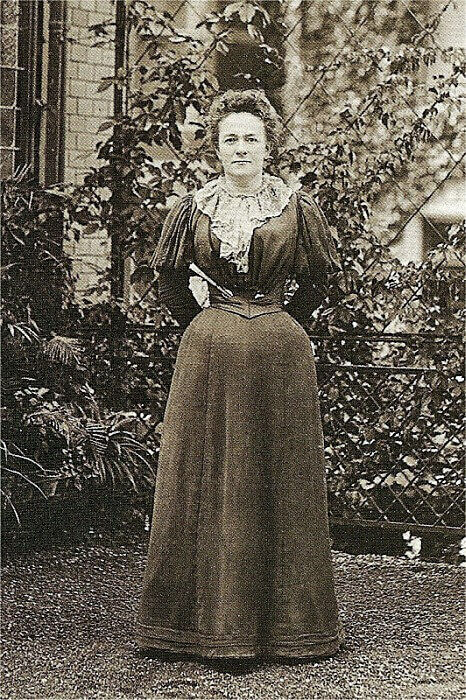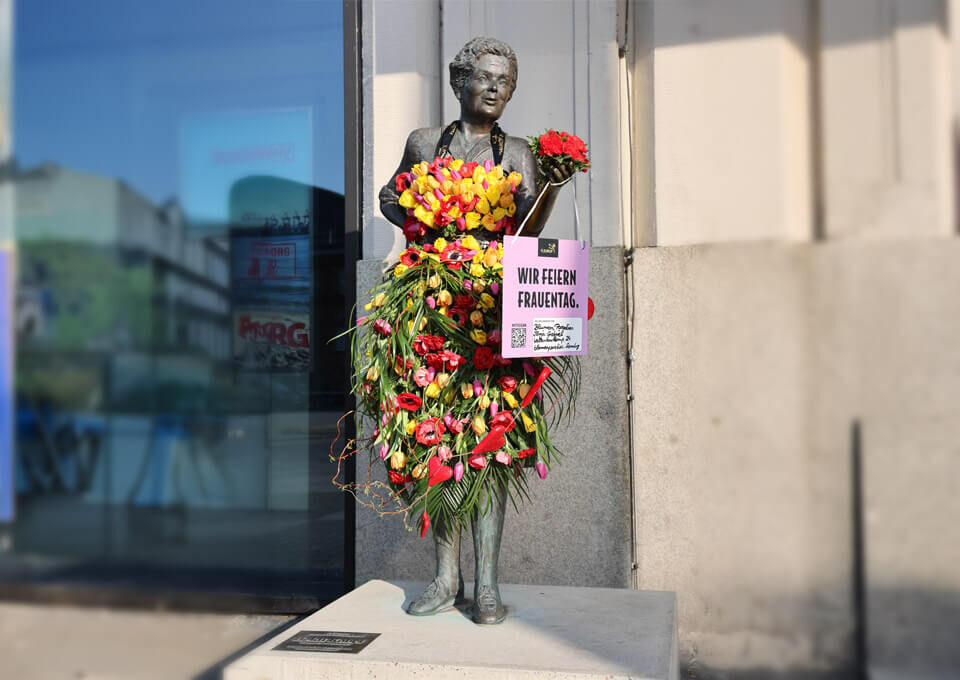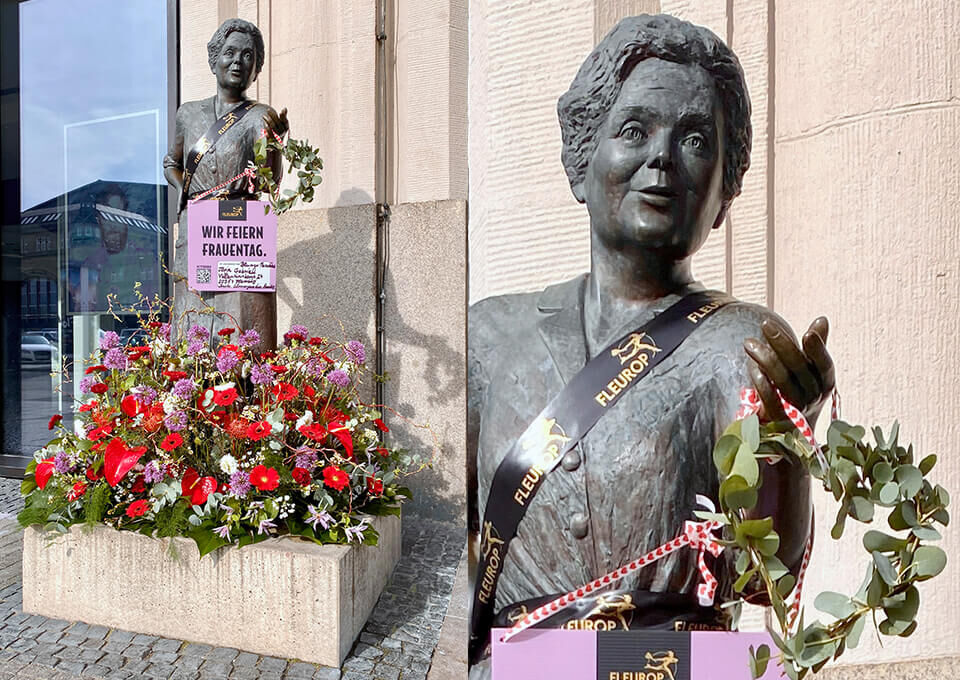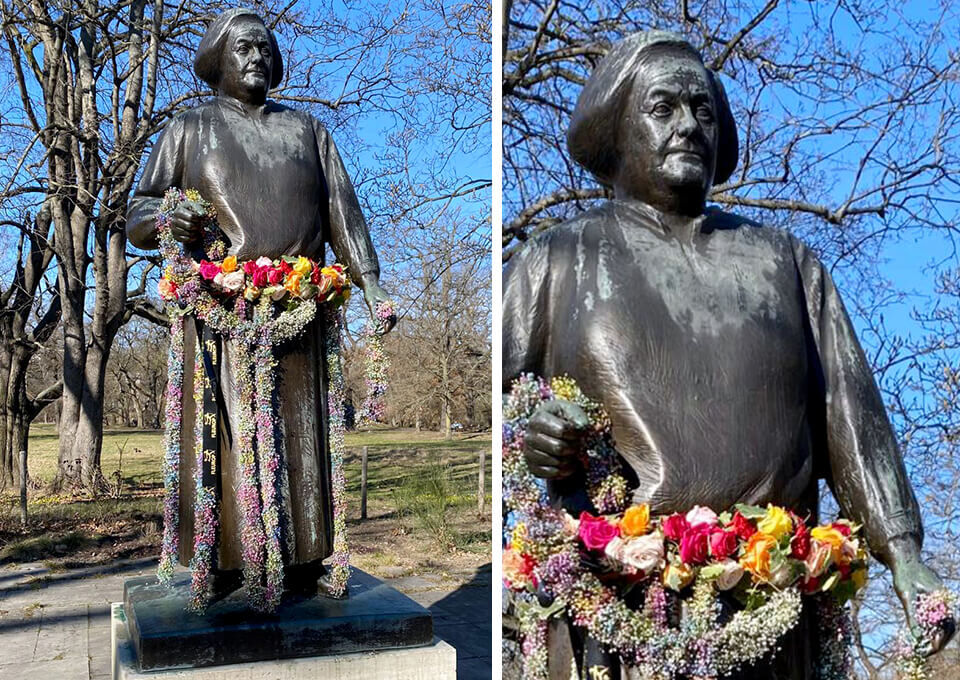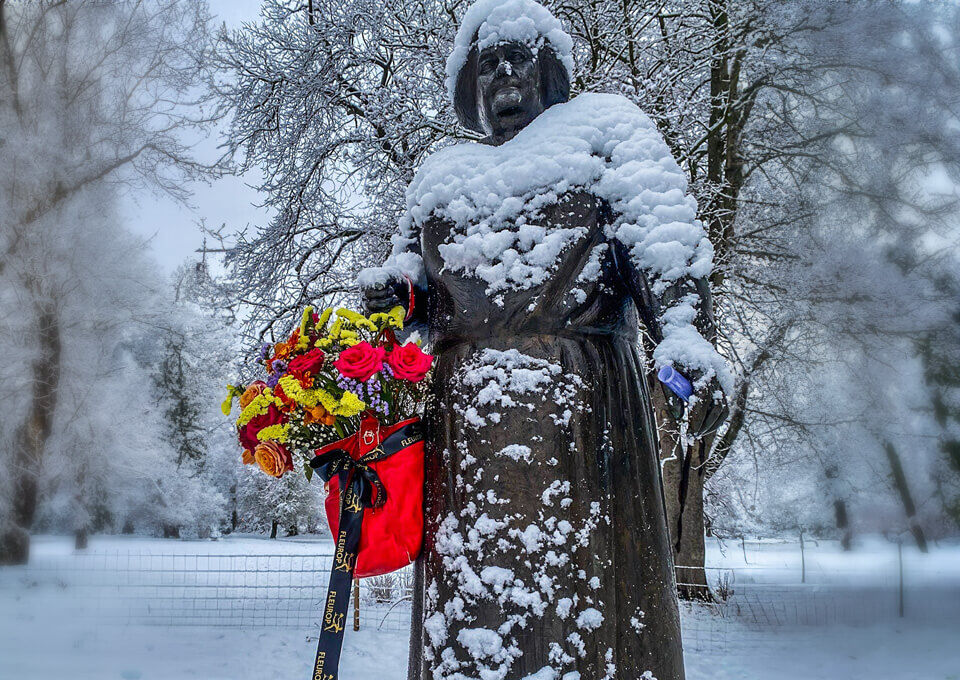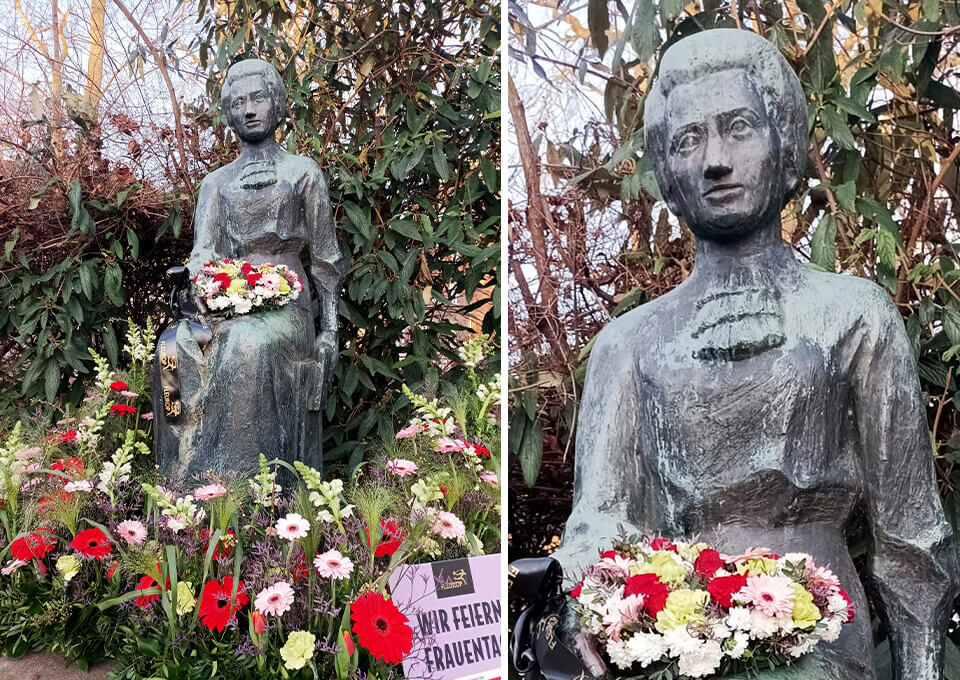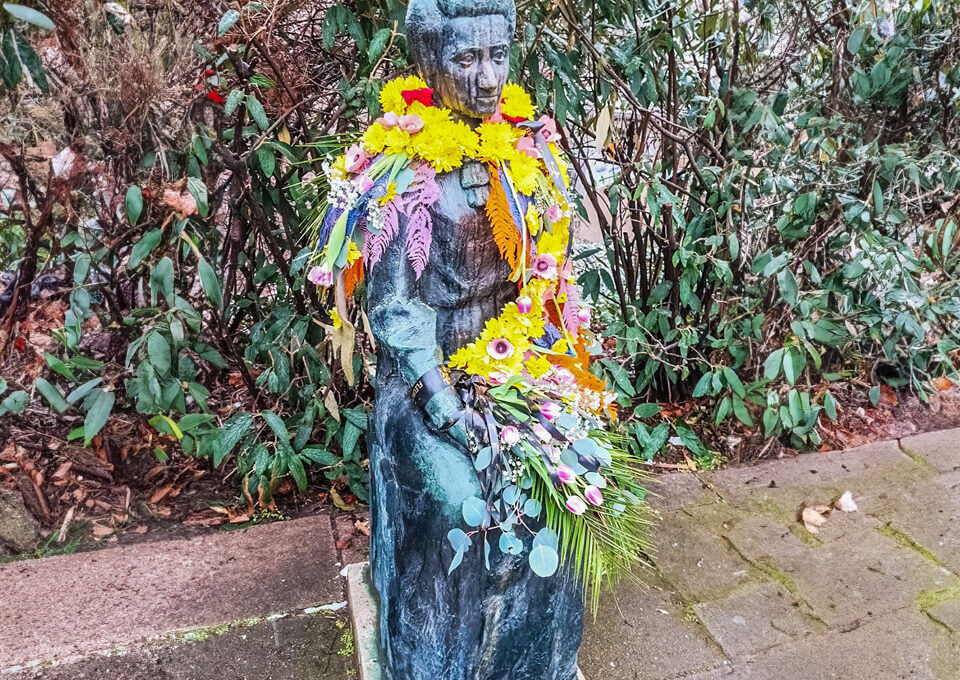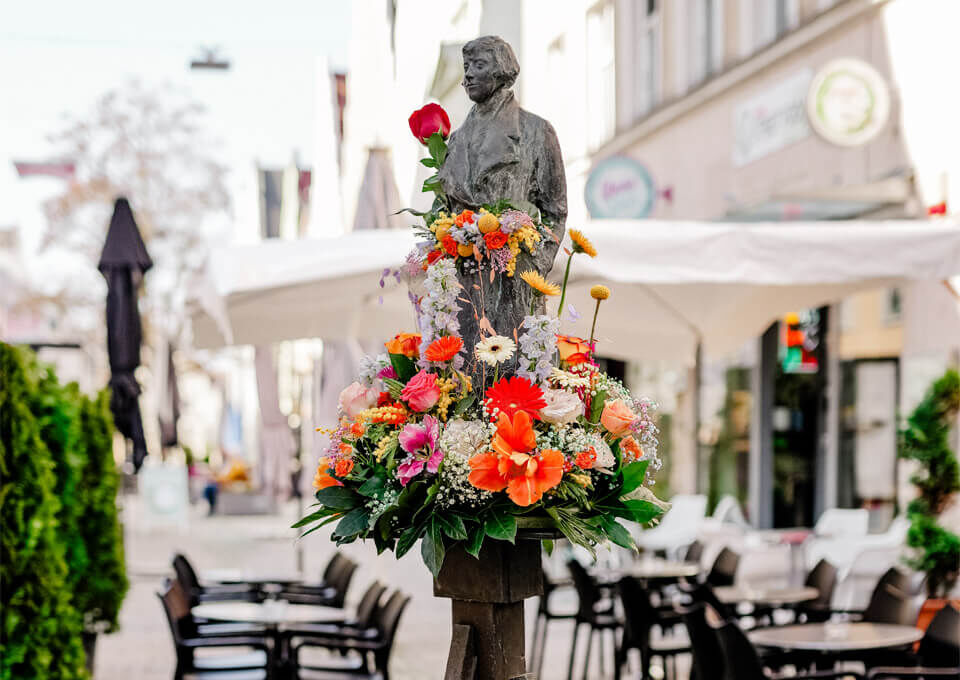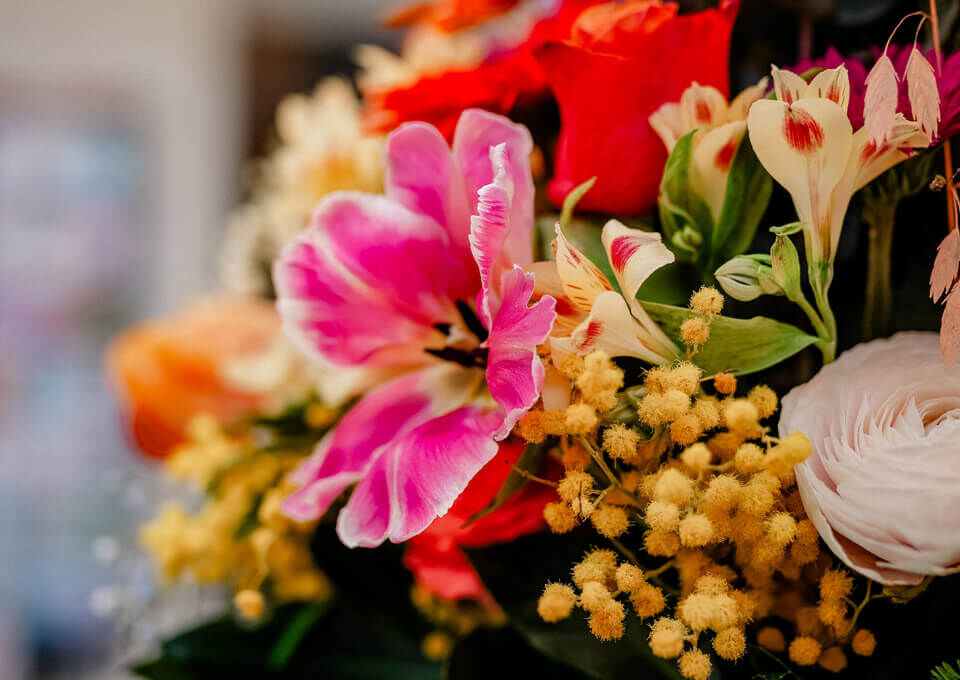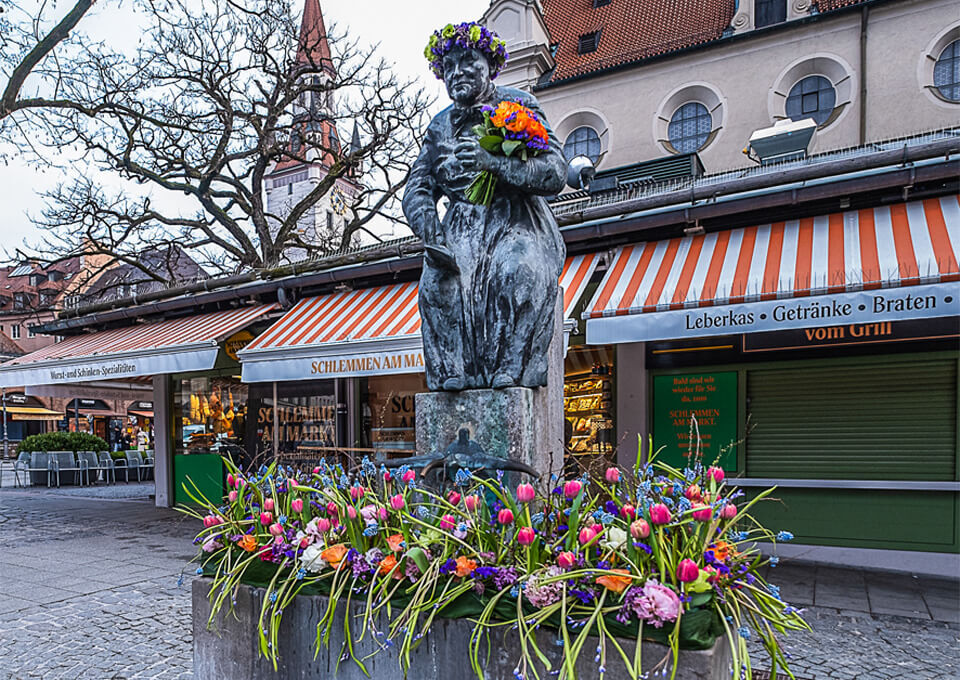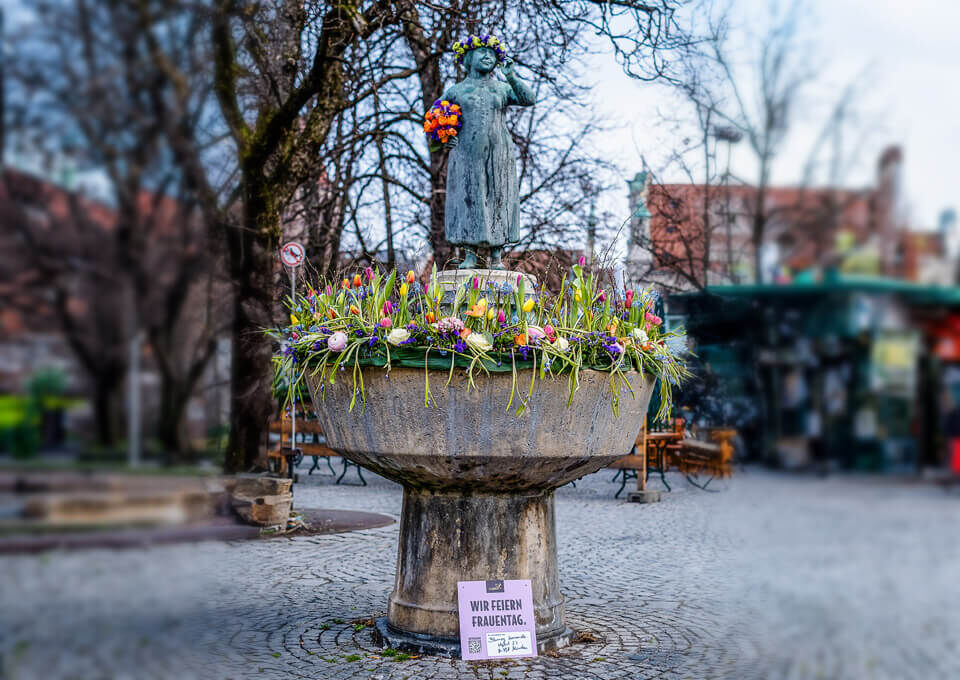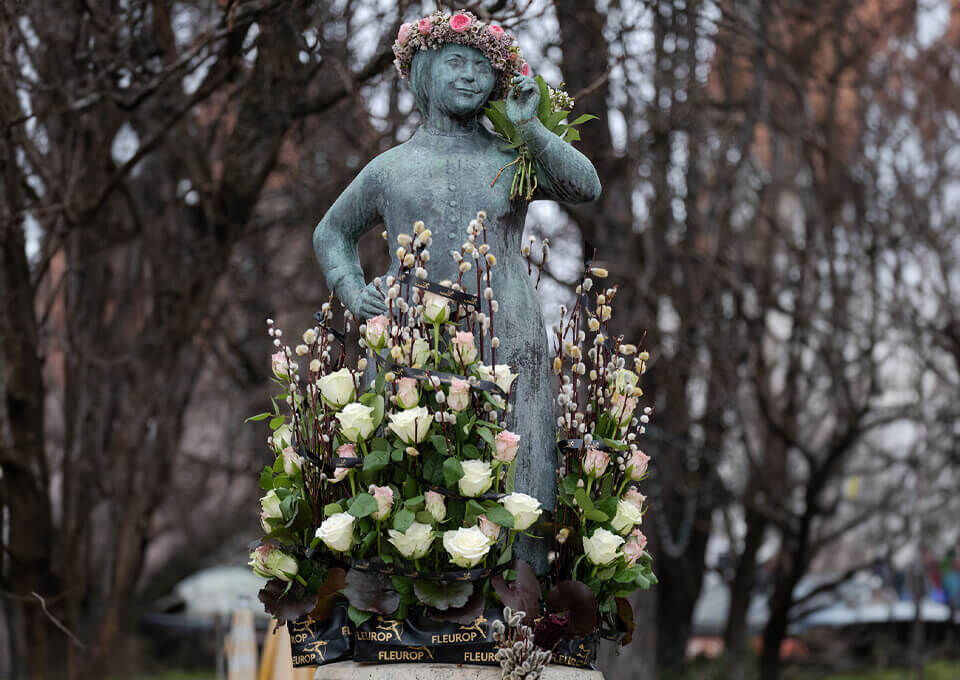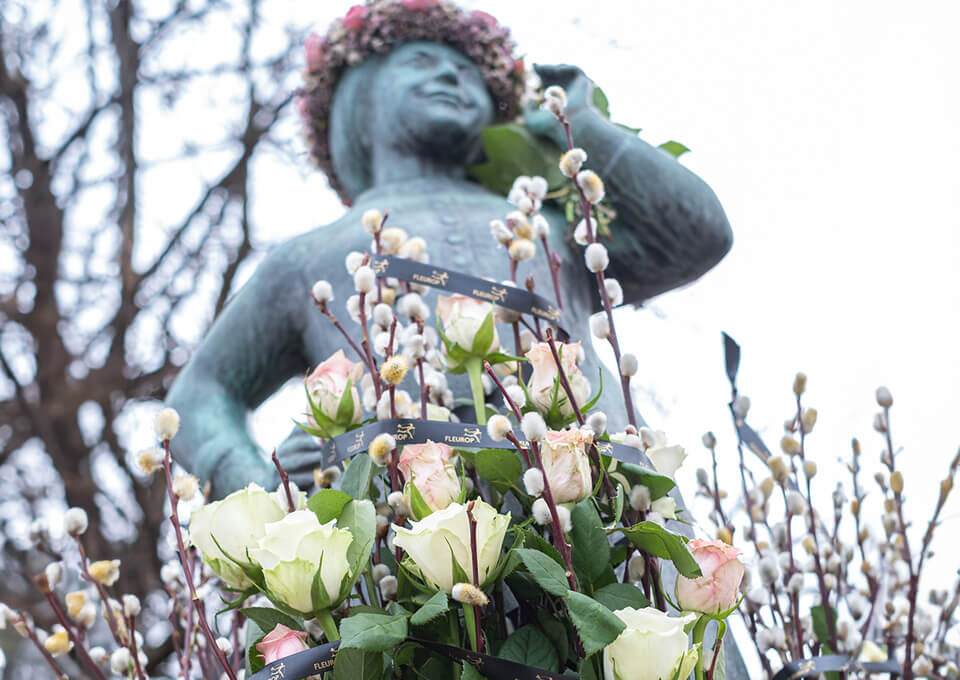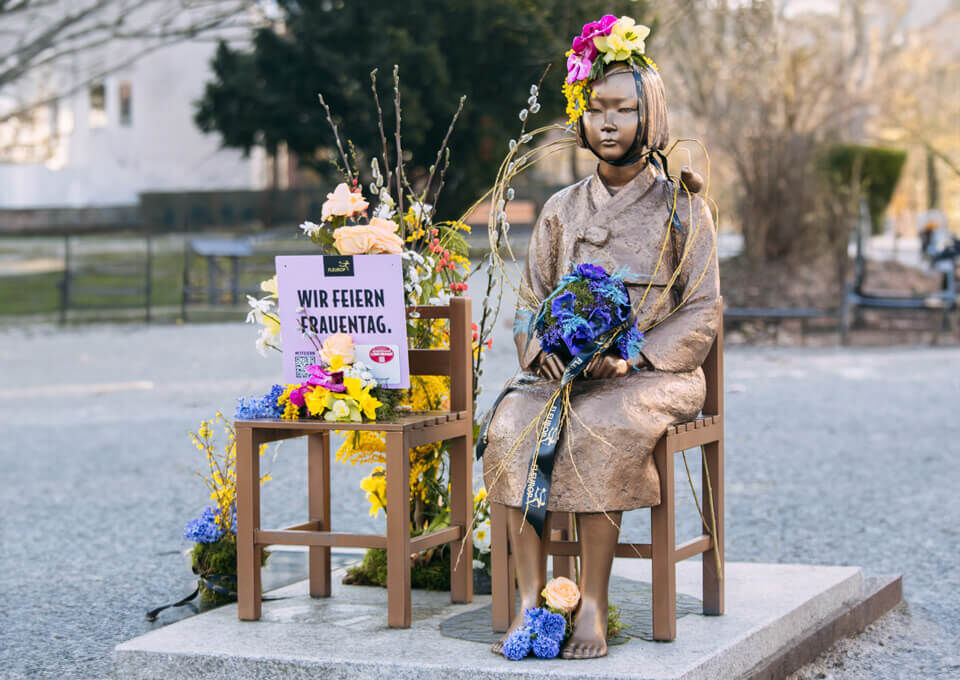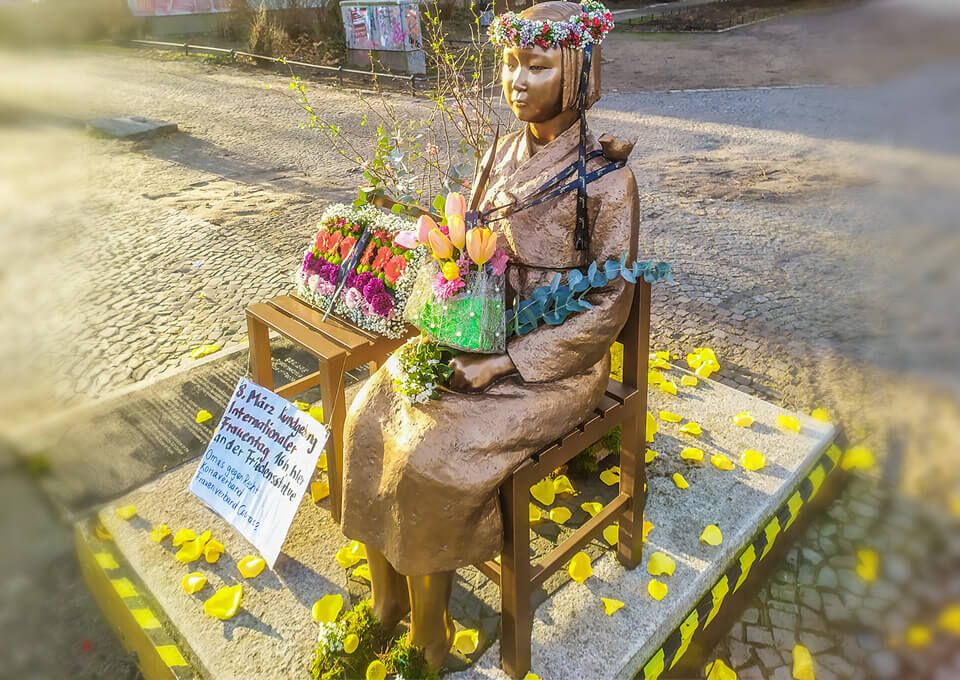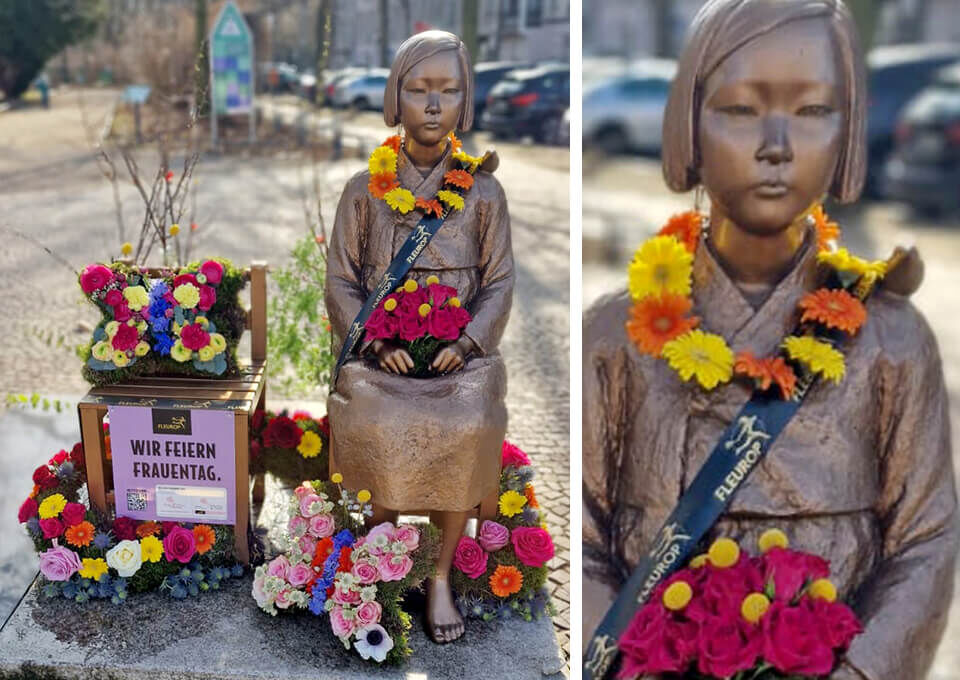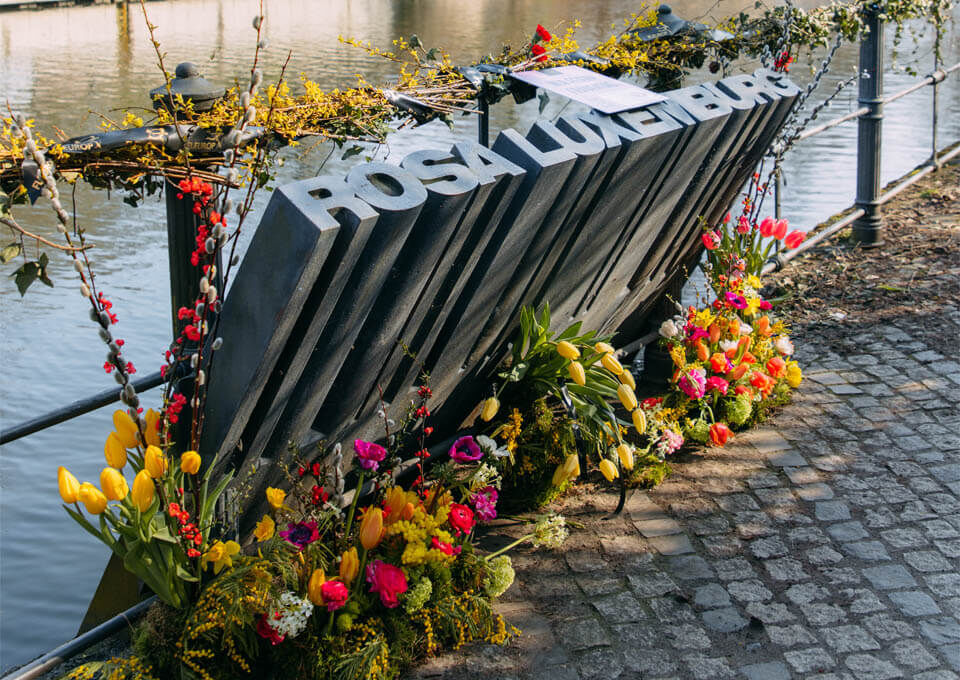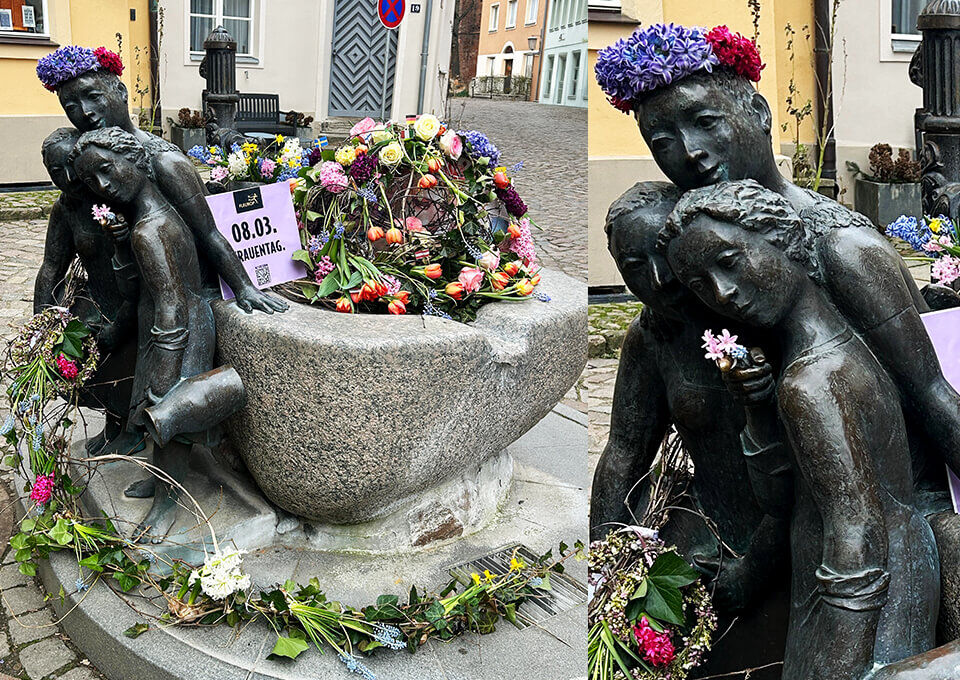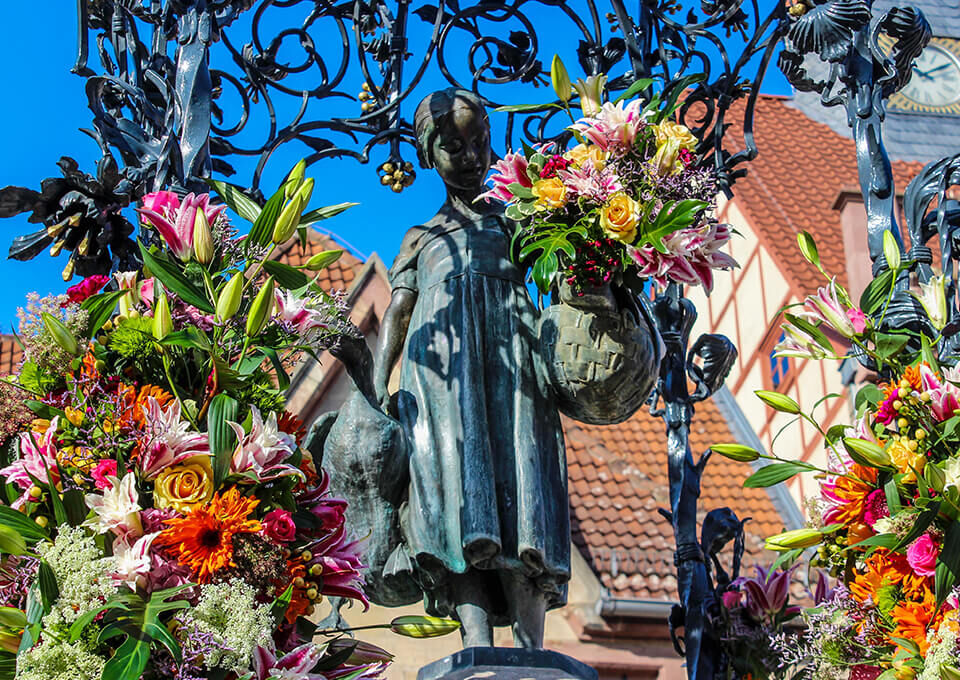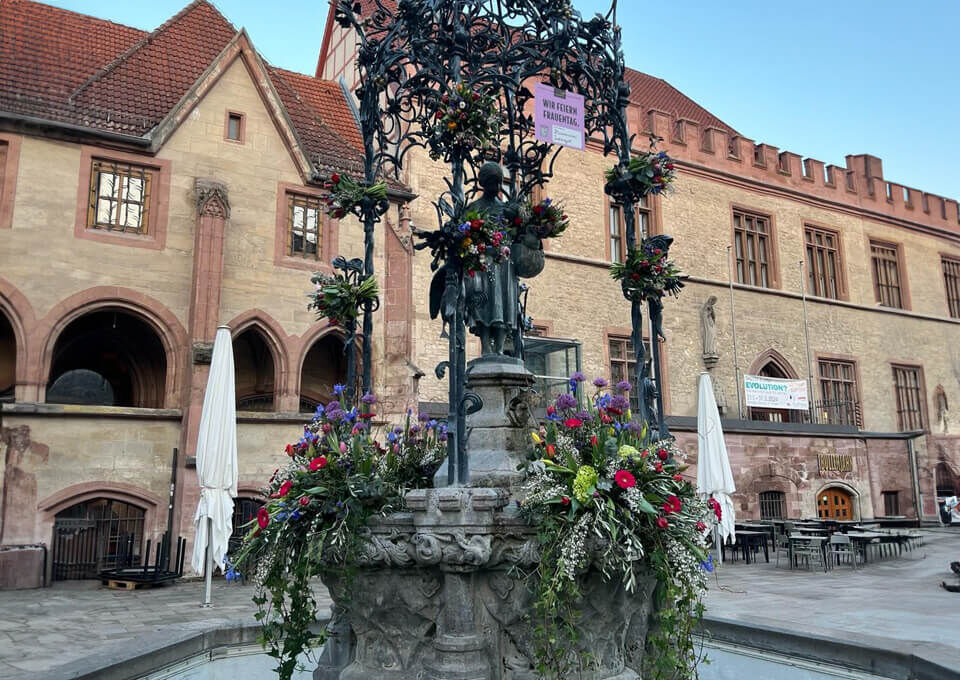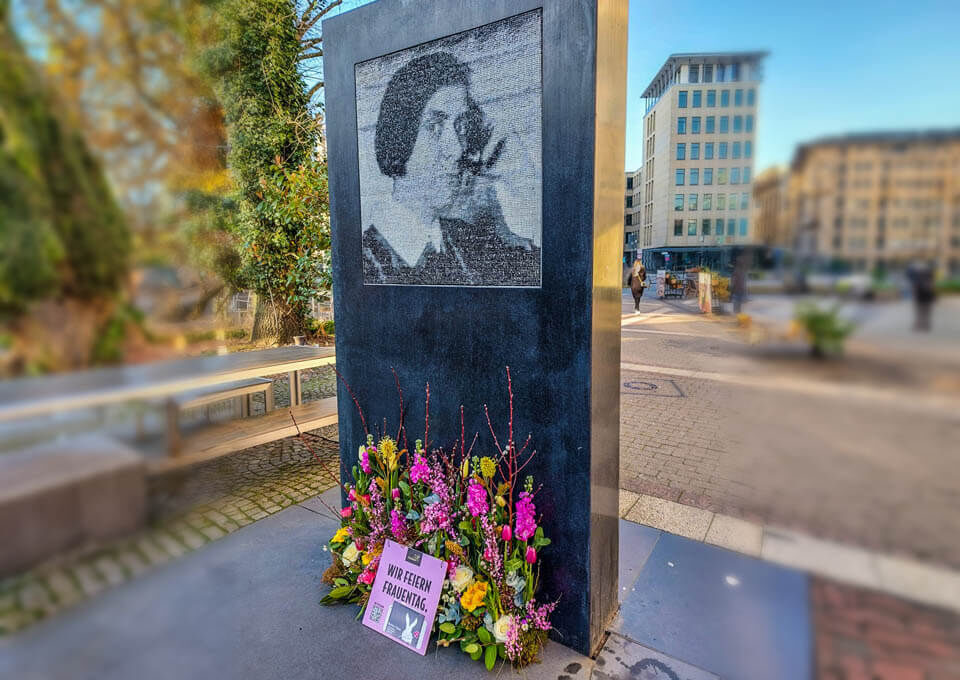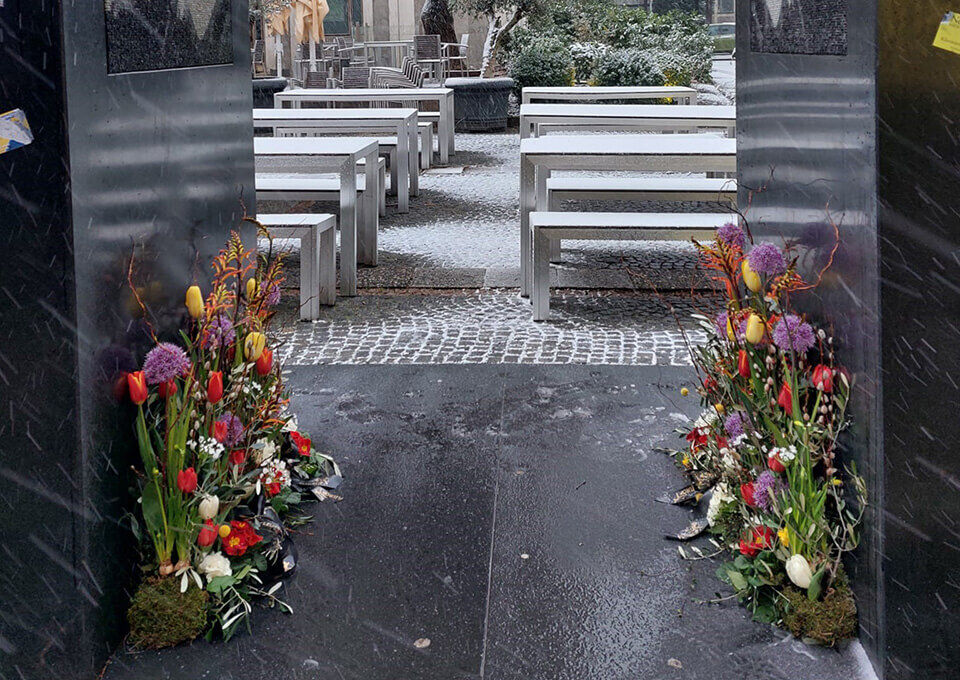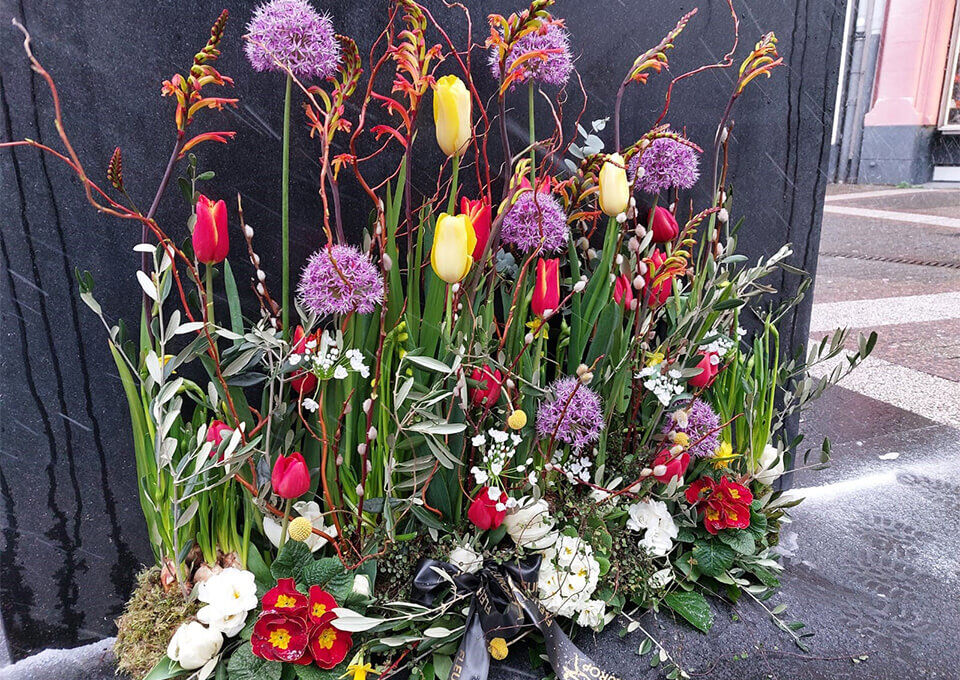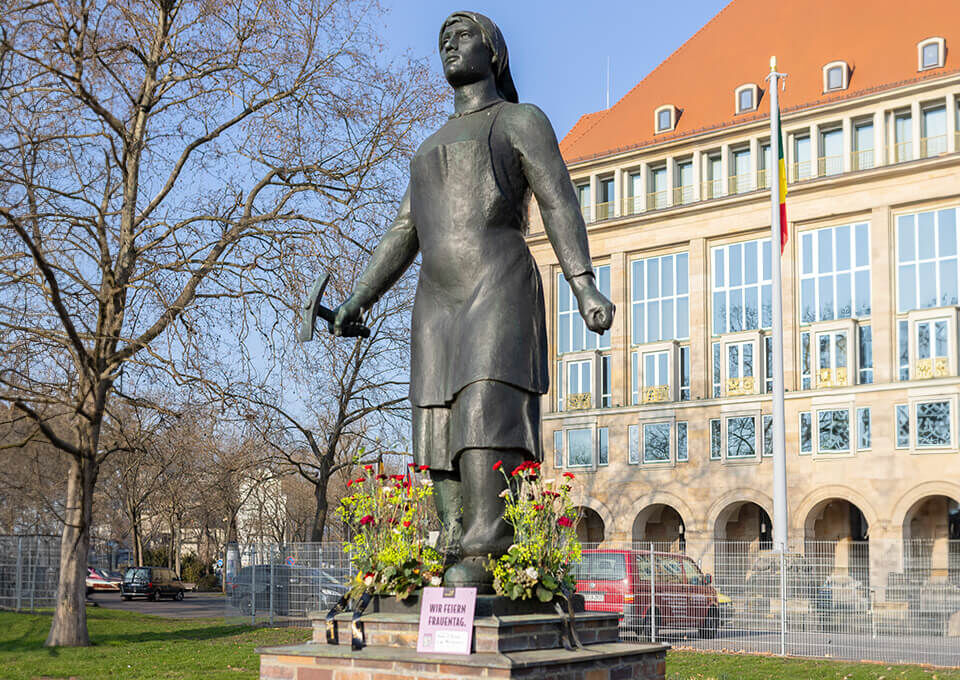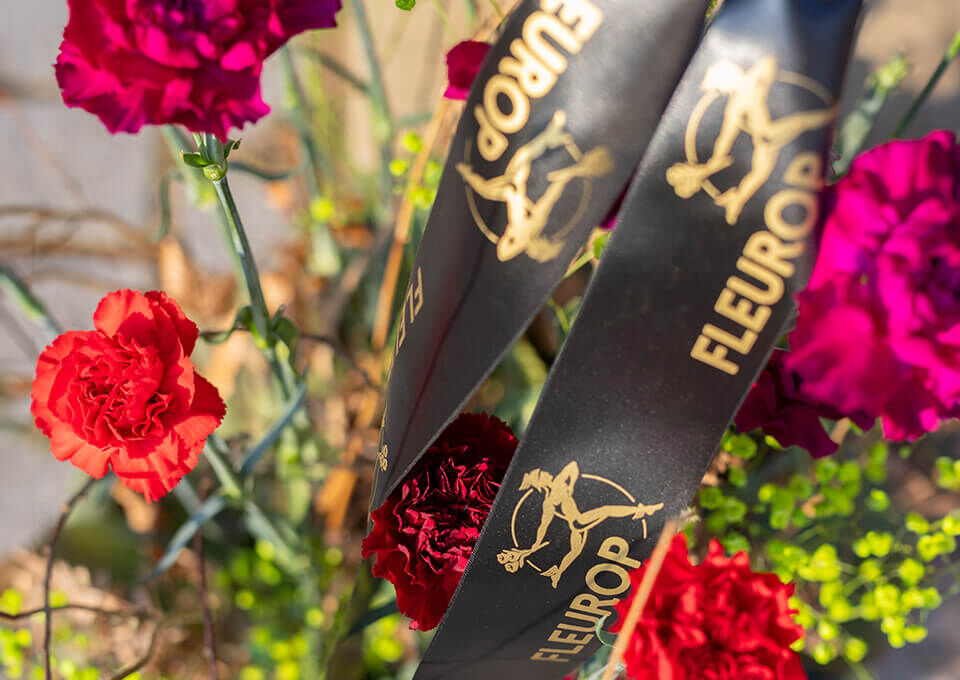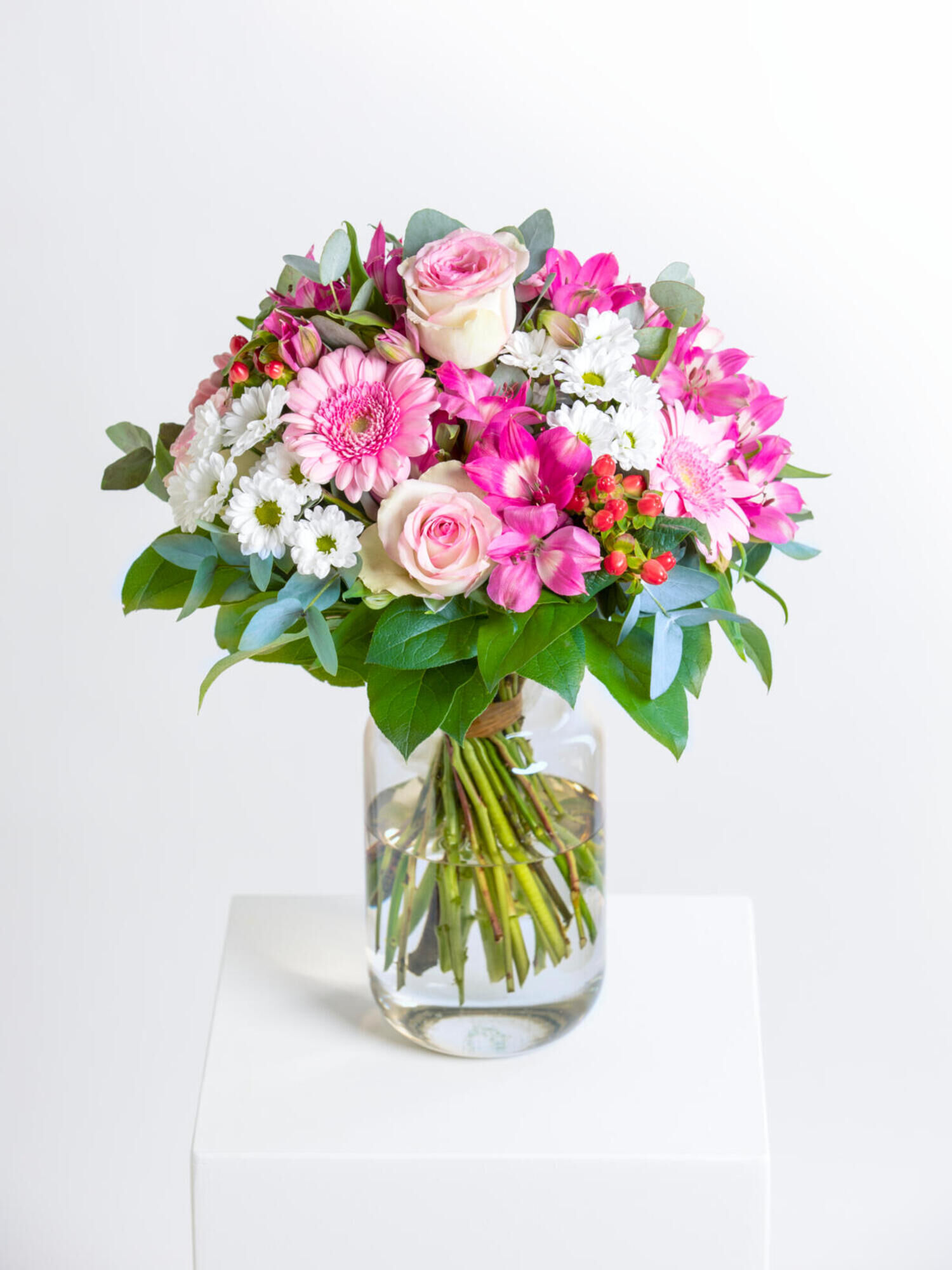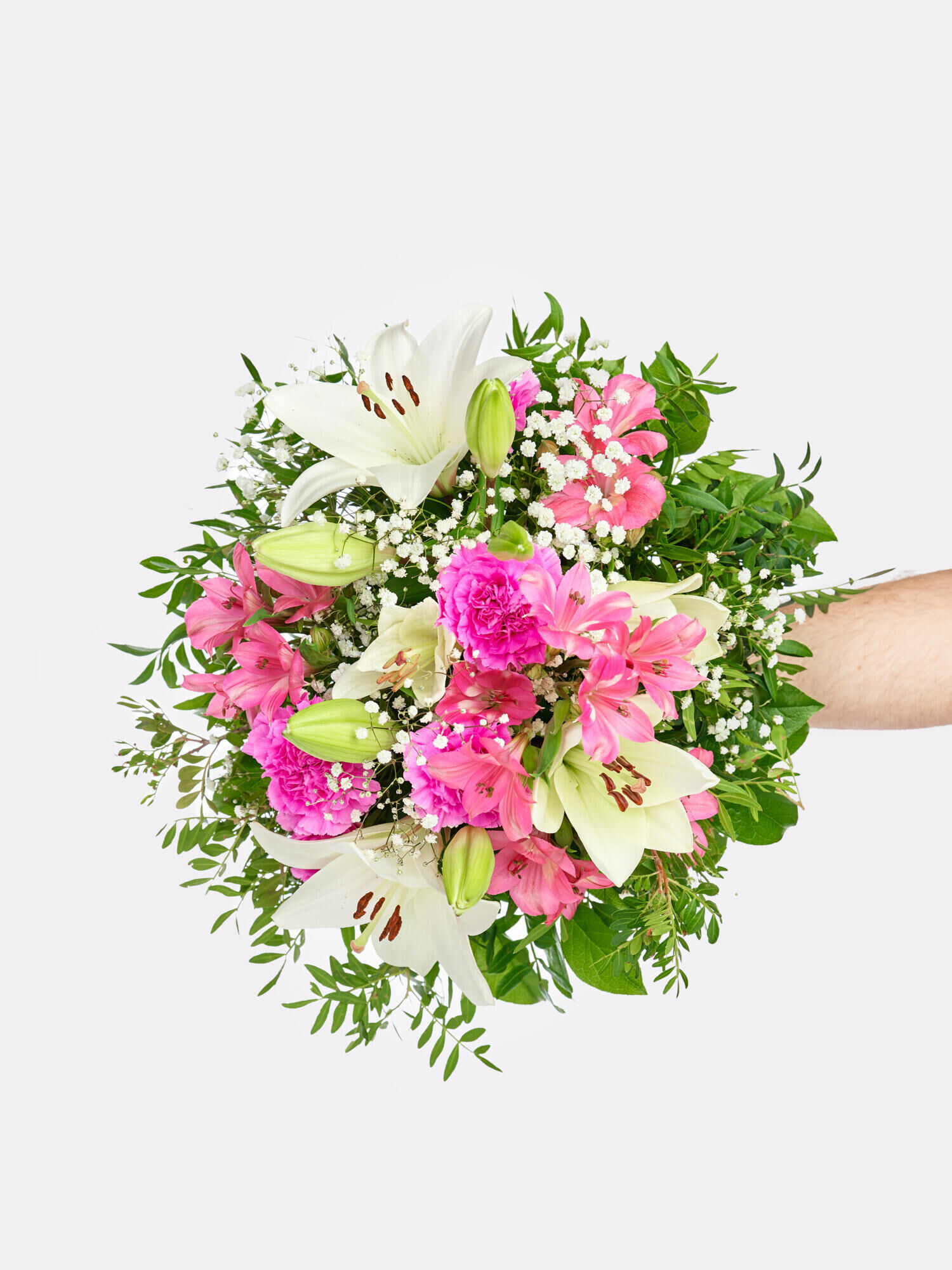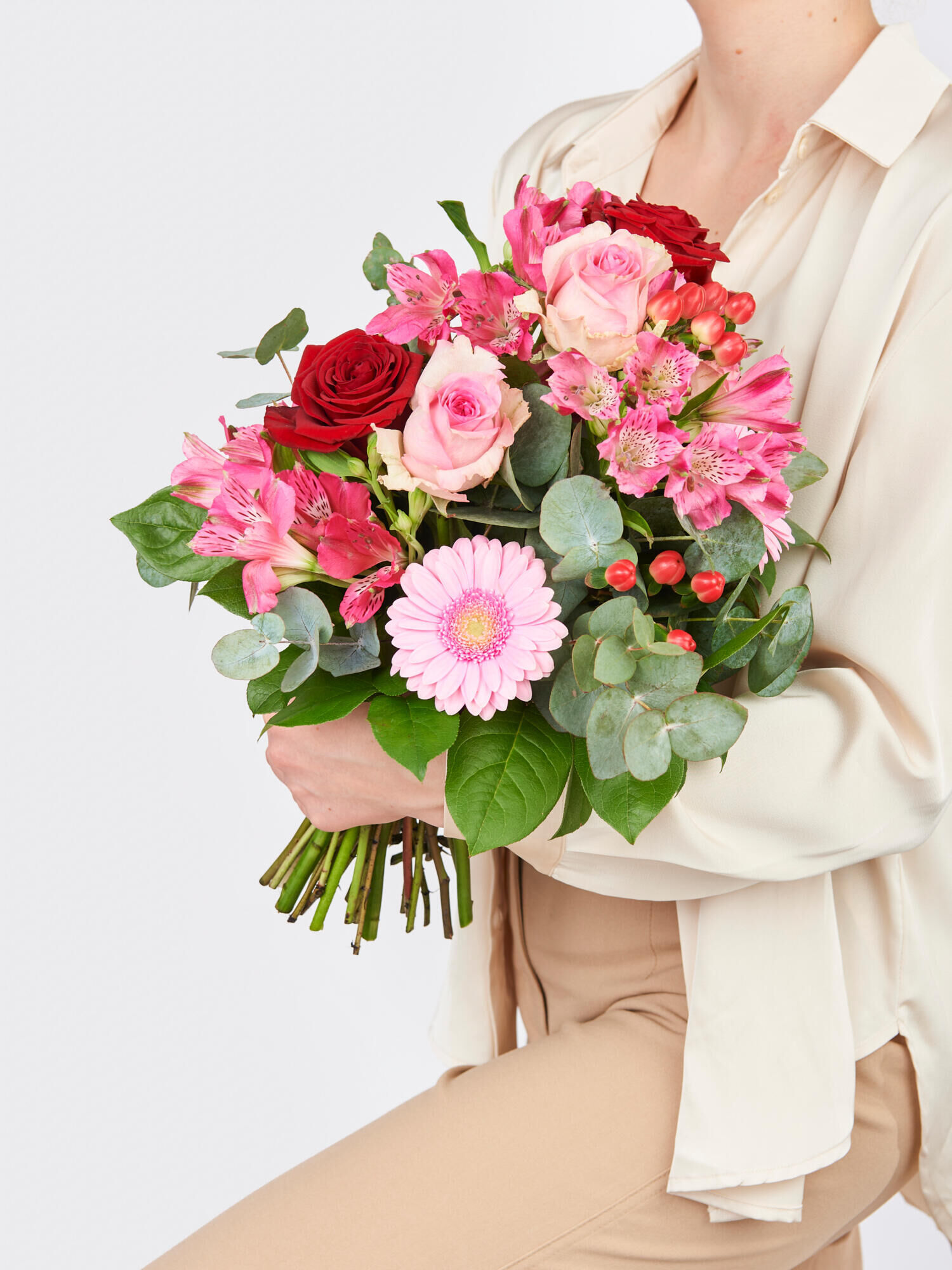International Women's Day
Traditionally, people at home and abroad celebrate a very special event on 8 March: International Women's Day. Its origins go back to the beginning of the women's rights movement in the early 20th century.
Officially banned during the Nazi era because of its socialist character, Women's Day took on a very different meaning in divided Germany after the Second World War. The Soviet occupiers reintroduced it as early as 1946. In the GDR, it retained the character of a socialist event for a long time, but it was not until the late 1980s that 8 March was celebrated there in a more festive, informal and less ideological way. In the FRG, social democrats started to organise women's days again in 1948, but the original meaning was lost quite quickly. It was only with the commitment of a new women's movement at the end of the 1960s that 8 March became more prominent again in the Federal Republic and other western countries. In December 1977, the United Nations General Assembly decided to recognise the date as International Women's Day, also to denounce the still widespread oppression of women in various regions of the world.
In Germany, especially in the new federal states, Women's Day is still celebrated gladly and actively, both in private and in working life.
Women's Day is more than just a day

In 2026, we are once again sending a floral signal of recognition and appreciation to all women. In previous years, 2023, 2024 and 2025, Fleurop florists have already decorated memorials to women throughout Germany with flowers. We are continuing this tradition - and expanding it: This year, we are starting the week before Women's Day and continuing the campaign on various days until 8 March.
With this initiative, we are drawing attention to the significant contributions of women who - despite the comparatively small number of monuments dedicated to them - have made unforgettable contributions to our society. It is a visible commitment to honouring the achievements of women in history and at the same time raising awareness of the existing inequality in public recognition.
We will decorate the following statues of women in 2026
Berlin: Käthe Kollwitz
Käthe Kollwitz (1867-1945) was one of the most famous artists of the 20th century, best known for her depictions of social misery, war and human suffering. She used her art to protest against social injustice and her ability to depict profound human suffering without diminishing the dignity of her figures makes her work universal and timeless. Her most famous work: the cycle "A Weaver's Revolt" shows poor weavers fighting against their exploitation.
Decorated by: Blumen Vanessa
Hamburg: Heidi-Kabel-Statue
Heidi Kabel (1914-2010) was a folk actress at the Ohnsorg Theatre in Hamburg for 66 years, a film actress, singer and radio play narrator - in particular, she made Low German ready for the stage. She was particularly appreciated for her portrayal of strong, down-to-earth female characters. She was also known for her social commitment to the socially disadvantaged. She received numerous awards for her life's work, including three Bambis. Her warm-heartedness, her commitment to the community and her artistic work made her a legendary figure in German popular theatre.
Decorated by: Gabriel Tanja - Blumenparadies

Hamburg: Zitronenjette
Born Henriette Johanne Marie Müller in Dessau in 1841, the Zitronenjette was a well-known trader in Hamburg. From the age of 13, she roamed the streets of Grasbrook and the pubs of St Pauli with fresh lemons. Her cry of ‘Zitroon, Zitroon, fresh Zitroon!’ made her a popular figure. In 1986, a monument was erected in her honour in Hamburg. It shows her in her typical pose, her hand outstretched. The bronze hand has now been touched so often that it shines - a gesture that is said to bring good luck. Zitronenjette remains unforgotten as one of Hamburg's originals, a symbol of the lives of ordinary people who struggled through life with their daily hardships.
Decorated by: Gabriel Tanja - Blumenparadies
Leipzig: Clara Zetkin
Clara Zetkin (1857-1933) was a socialist and women's rights activist who spent her life campaigning for equality, workers' rights and international peace. She played a central role in the international socialist movement and was instrumental in the founding of International Women's Day on 8 March, which was first celebrated in 1911. She was convinced of the need to combine the fight for women's rights with the fight for social justice and against capitalism. Clara Zetkin remains a source of inspiration for feminist and socialist movements worldwide to this day.
Decorated by: Blumenhaus Stopp GmbH
Erfurt: Rosa Luxemburg
The most famous quote by Rosa Luxemburg from her 1918 manuscript "The Russian Revolution": "Freedom only for the supporters of the government, only for members of a party - however numerous they may be - is not freedom. Freedom is always freedom for those who think differently. Not because of the fanaticism of "justice", but because all that is instructive, salutary and purifying about political freedom depends on this essence and fails of its effect when "freedom" becomes a privilege."
Decorated by: Gloriosa Floristik
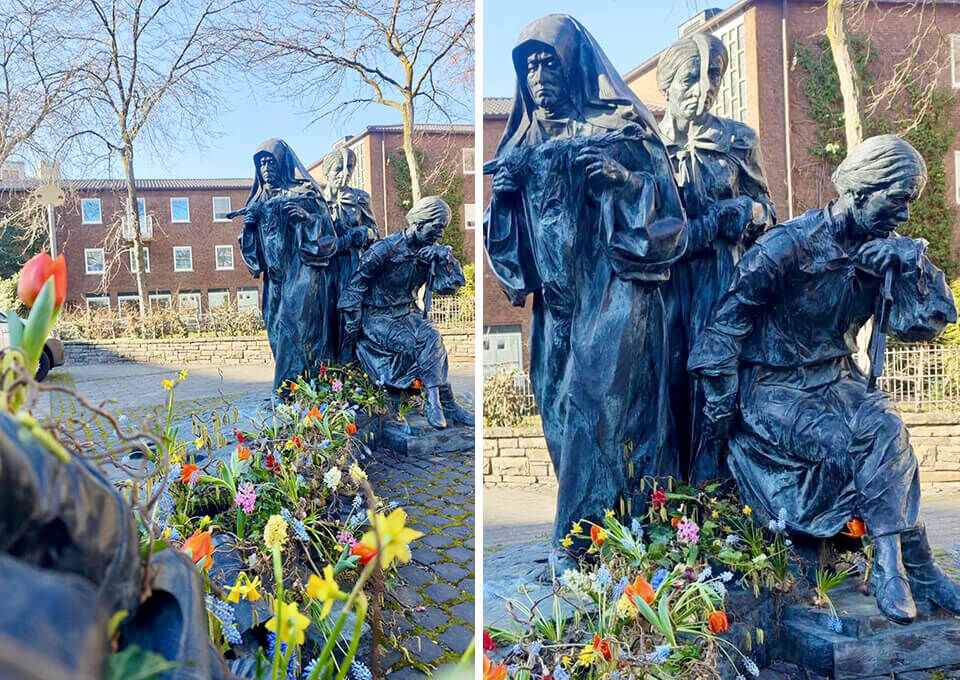
Cologne: Edith Stein Monument
Edith Stein, also known as Teresa Benedicta of the Cross, was a German-Jewish philosopher and women's rights activist. She was born Jewish in Breslau in 1891. She worked intensively on the role of women in the church and in society and tried to develop a deeper understanding of how women could be recognised and respected in both religious and secular contexts. She was murdered in the Auschwitz concentration camp in 1942. Edith Stein is considered a fascinating example of the dialogue between faith and reason, and her life story has inspired people in many different contexts. She was beatified by the Catholic Church in 1987 and canonised in 1998.
Decorated by: Blumen von Steiner

Munich: Statue of Juliet Capulet
The Juliet Capulet statue in Munich is a replica of the original statue from Verona and symbolises love and hope despite a tragic fate. It is reminiscent of the famous character of Juliet from Shakespeare's ‘Romeo and Juliet’, who symbolises her unwavering love and longing for the forbidden Romeo. The statue has adorned the square by the Old Town Hall since the 1970s and attracts numerous visitors who seek their happiness in love - whether by touching the statue or leaving flowers and padlocks.
Decorated by: Blumen Komander
women's statues all over germany
In recent years, we have honoured the following women:
In Baden-Württemberg
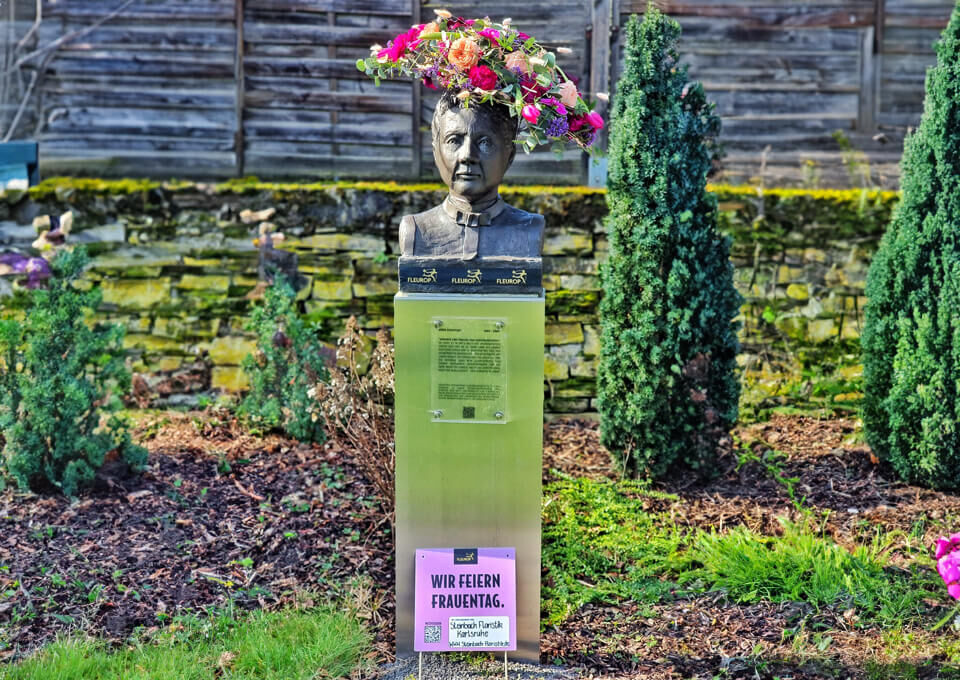
Karlsruhe: Erna Scheffler
Erna Scheffler (1893 - 1983) was not only the founding president of the Soroptimist Club Karlsruhe, she was also the first female judge to be appointed to the Federal Constitutional Court in Karlsruhe. The daughter of an oil mill owner, she was born in Breslau on 21 September 1893, studied law as a young woman and passed her second state examination in 1925. After the end of the Second World War, she initially worked in Berlin, then moved to the Düsseldorf Administrative Court in 1949 before coming to Karlsruhe in 1951. As early as 1950, she spoke at the German Lawyers' Conference in favour of equal rights for men and women, an issue she pursued throughout her life. The Soroptimistinnen Karlsruhe are honouring Erna Scheffler's gravesite with the creation of a bust by the sculptor Bronislava von Podewils.
Decorated by: Steinbach Floristik
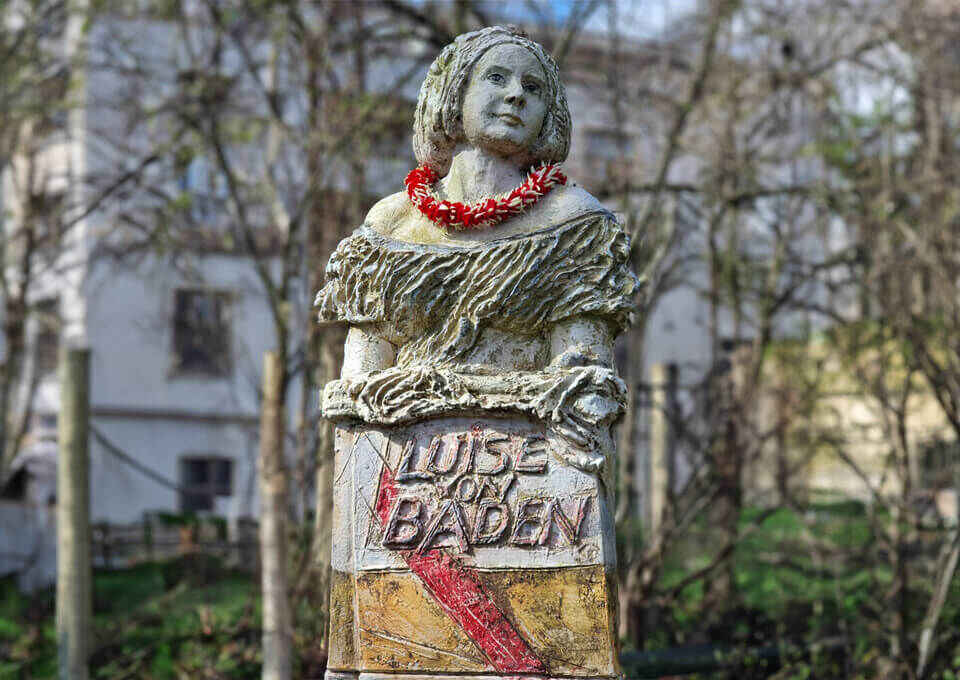
Karlsruhe: Luise von Baden
Luise Marie Elisabeth von Baden (1838-1923), born Princess of Prussia, was the daughter of Emperor Wilhelm I of Germany. She was known for her social commitment and charity work. She actively promoted the founding and support of social institutions such as hospitals, educational centres and orphanages. Her work had a significant impact on improving social conditions in Baden. Her connections to the leading European dynasties, including through her relationship with the British Queen Victoria, strengthened her role in the diplomacy and society of her time. Luise von Baden is still honoured today for her deep social awareness and her commitment to improving social conditions.
Decorated by: Steinbach Floristik
In Bavaria
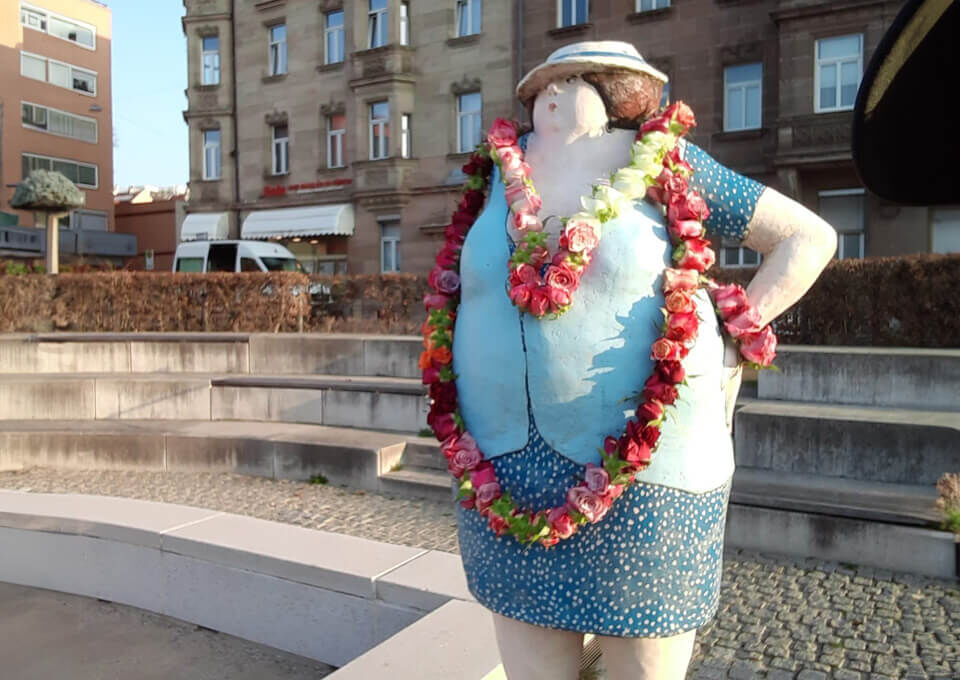
Fürth: Fountain Billinganlage
The ironically exaggerated figures provide life and variety - the female role dominates in this bizarre interplay of a colourful society. The women are completely at peace with themselves and this place. The sculptor makes no claim to philosophical depth with this depiction, yet the aesthetics of the design not only represent the acceptance of diverse body images, but also emphasise the presence of women.
Decorated by: Blumenhaus am Espan
Ingolstadt: Marieluise Fleißer
Marieluise Fleißer (1901-1974) wrote her first play at the age of 22. Her texts deal with the war between men and women, speechlessness and misunderstanding, the longing for closeness, desire, violence and oppression. When she describes couple scenes, they are always fight scenes. Marieluise Fleißer has always dared to write about taboo subjects, even though scandals and outrage are the result. The naturalistic and blunt way in which Fleißer dealt with topics such as sexual exploitation and the oppression of women in a patriarchal society stood in stark contrast to the conservative moral concepts of the time. Scenes showing sexual permissiveness and criticism of military and bourgeois authorities were particularly provocative.
Decorated by: BELLEZZA flower
Munich: Elise Aulinger
Elise Aulinger (1881-1965) was one of the most popular Bavarian folk actresses. She managed to bring the characteristics of her characters to life and convey authenticity through her acting. She began her radio career in 1925 with a reading, establishing a tradition of Bavarian radio that continues to this day. Even though her name may not be as well known today, she was still considered one of the leading character actresses of her time in the genre of popular theater.
Decorated by: Blumen Komander
Munich: Liesl Karlstadt Fountain
Liesl Karlstadt (1892-1960) was an important actress and comedian. Together with her stage partner Karl Valentin, she performed as a successful comedy duo for 26 years. Liesl Karlstadt was known for her versatility and comedic talent. However, her career was hampered by health problems and crises, which kept her away from the stage for a time. Nevertheless, she left behind an impressive artistic legacy that is still remembered today.
Decorated by: Blumen Komander

Regensburg: Sculpture "Three Muses of Music"
Three women playing the violin, tuba and guitar: The depiction of the muses as female figures representing creative inspiration and musical expression emphasizes the importance and contribution of women in music. It emphasizes the role of women not only as muse and source of inspiration, but also as active creators and interpreters of musical art. Accordingly, the sculpture can be interpreted as a recognition of women's abilities and contributions to culture and a critique of their historical marginalization.
Decorated by: Blumenhaus am Hochweg
In Berlin
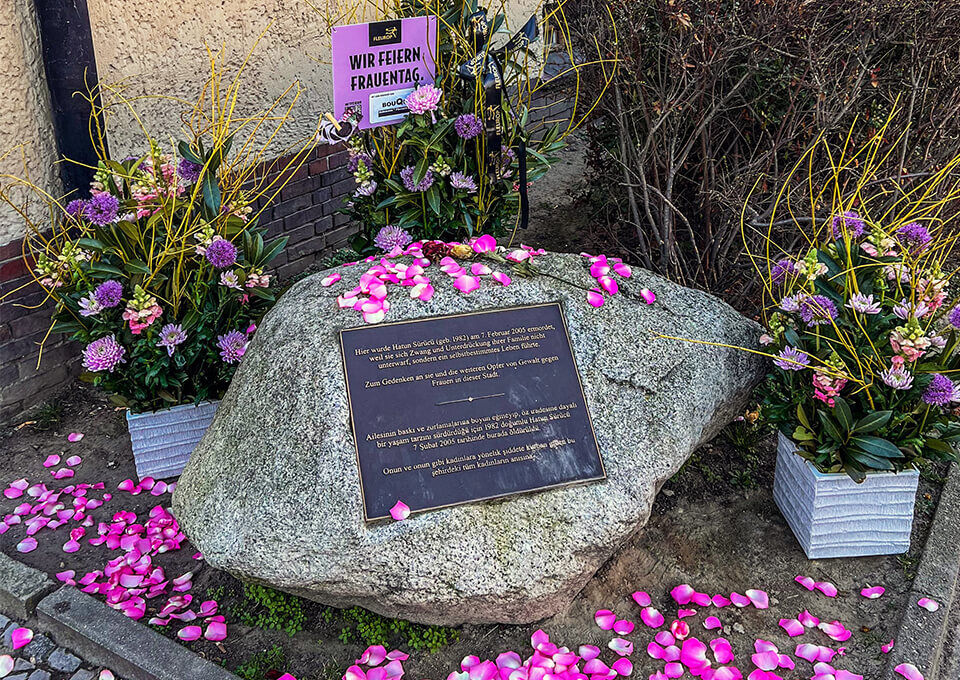
Berlin: Hatun Sürücü
This year marks the 20th anniversary of Hatun Sürücü's death. The then 23-year-old German-Kurdish woman was the victim of a femicide in Berlin on 7 February 2005. The murder caused nationwide horror, as Hatun had the courage to break out of the role model prescribed by her family and lead a self-determined life. She had left a forced marriage, took off her headscarf, completed her secondary school leaving certificate and began an apprenticeship as an electrician. Her death remains an inconceivable example of violence against women.
Decorated by: Bouquet - Heike Salzmann
Berlin: Peace dams
The peace statue is a memorial to the comfort women - women and girls who were systematically abducted by Japanese soldiers during the Second World War and forced into sexual slavery. It is estimated that 200,000 women and girls were involved. The peace statue thus stands as a symbol against war crimes and a sign of hope for these women and for victims of sexualised violence worldwide.
Decorated by: Andy's u. Mona's Blumentraum
Berlin: Rosa Luxemburg
Rosa Luxemburg (1871-1919) is still regarded as a symbolic figure of left-wing politics today. Many see her as the greatest left-wing politician of the 20th century or even of all time. She was an important Marxist theorist, socialist and revolutionary who is known for her role in the socialist movement against capitalism and monarchy in Germany and internationally. After the First World War, there was a revolution in Germany and at the beginning of 1919 she was treacherously murdered. Her legacy as a theorist, activist and symbol of the fight against oppression and for social justice lives on in many political movements around the world. Her fighting spirit and determination were extraordinary and make her a role model for many.
Decorated by: Andy's u. Mona's Blumentraum

Berlin: Trümmerfrauen memorial
The Trümmerfrauen memorial honours all the women between the ages of 15 and 50 who were involved in rebuilding the city in the post-war period. In 1946, the new newspaper of the East German CDU warned that a woman's main task was still to be a housewife, mother and to give birth. It was not until 1965 that the former women of the rubble were honoured by the Lord Mayor. The statue symbolises the recognition of female work, visibility in the public sphere and criticism of traditional gender roles.
Decorated by: Heide Blumenfachgeschäft
In Brandenburg
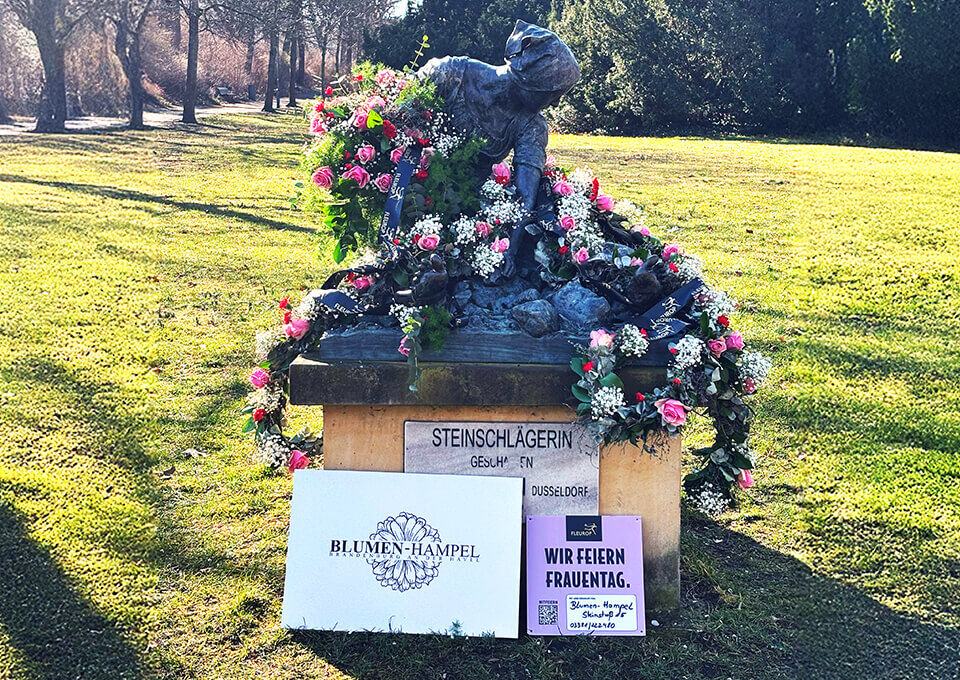
Brandenburg an der Havel: Stone cutter
The statue of the ‘Steinschlägerin’ is a reminder of the women who worked under harsh conditions in the industry over a hundred years ago. They performed hard, physical labour and often received only meagre wages in return. At the same time, they were left on their own to bring up their children and often had to take their infants to work with them. Karl Janssen took up this theme in 1902 and created the statue as a symbol of the double burden that women had to endure at the time. The ‘Steinschlägerin’ symbolises the tireless strength of these women, who nevertheless struggled to provide for and feed their families at a time when their achievements were often overlooked.
Decorated by: Blumen-Hampel
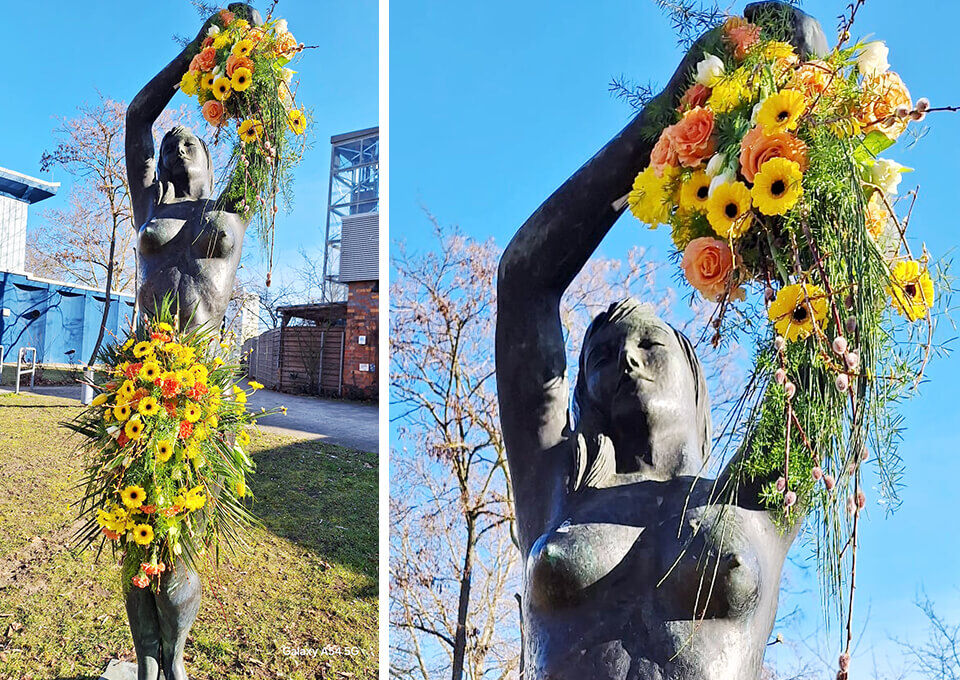
Potsdam: Sonja sports student
In the 1970s, sporting activity was seen as an important element of social and individual development - the sculpture epitomises these values. It symbolises the combination of science, education and physical culture, which were strongly promoted in the GDR, especially among young women. Sport was promoted at the time as a way of fostering health, discipline and community, and the figure of ‘Sonja’ symbolises a modern, active, academic woman in this context.
Decorated by: Blumenhandel Schmidt
In Bremen

Bremen: Agnes Heineken
Agnes Heineken (1872-1954) was an educator, women's rights activist and politician. At the time, access to education for women was systematically restricted and she campaigned for the education and advancement of girls and women. She was a pioneer in the educational landscape of her time, whose efforts contributed significantly to improving educational opportunities for girls and recognising the importance of women's education. Her work remains an important chapter in the history of education and the women's movement in Germany.
Decorated by: Blumenkorb An der Weide
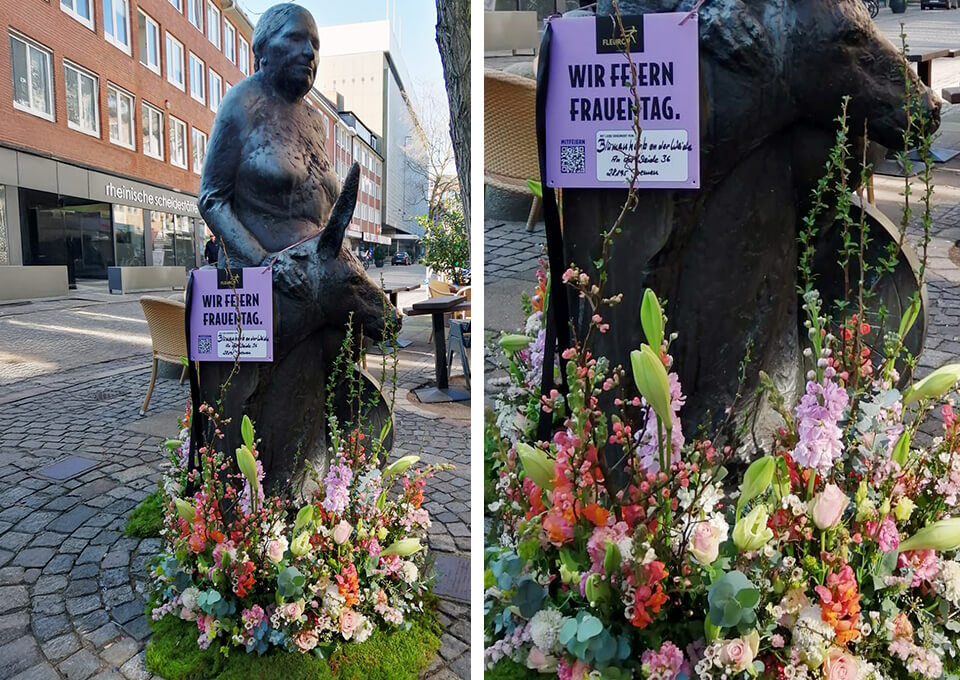
Bremen: Mudder Cordes
Metta ‘Mudder’ Cordes became known as a market woman in Bremen in the 19th century. After the sudden death of her husband in 1860, she was left with nothing. To secure her livelihood, she began selling vegetables in Bremen's Neustadt district, initially pulling the cart herself, then being given a dog and later a donkey named Anton to pull the cart. Mudder Cordes is still remembered today as an example of energy and perseverance and is considered one of Bremen's 19th-century originals.
Decorated by: Blumenkorb An der Weide
In Hamburg
In Hesse
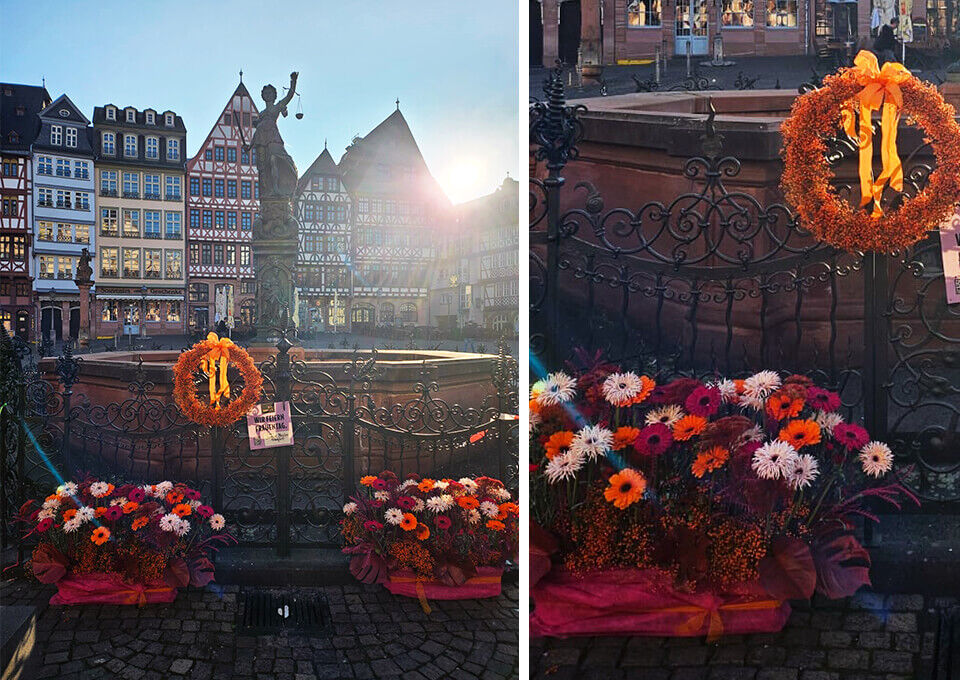
Frankfurt am Main: Fountain of Justice
The Fountain of Justice is a highly symbolic monument that epitomises the values of justice and the rule of law. The fountain was erected in 1543 and is located on the Römerberg, the city's historic market square. It depicts an allegorical figure of Justitia - the Roman goddess of justice. The scales stand for the weighing of arguments and the pursuit of balanced judgements, while the sword symbolises the enforcement of justice. The Fountain of Justice is therefore a memorial to the importance of fair justice and the pursuit of justice in a society. It is the oldest fountain in Frankfurt.
Decorated by: A + A Blumen-Meister GmbH
In Mecklenburg-Western Pomerania
Stralsund: The chatty women "Mägdebrunnen"
At first glance, the Mägdebrunnen seems to depict a stereotypical image of women, but the performance can also express social cohesion and mutual support. Historically, public spaces such as fountains were important places for women to meet and exchange information, which was often one of the few opportunities for women to participate in public life in a male-dominated society. It can therefore be interpreted as a tribute to the strength and perseverance of women in the community, who often maintain the social fabric through their relationships and communication.
Decorated by: Blumen Handels- und Beteiligungsgesellschaft mbH
In Lower Saxony
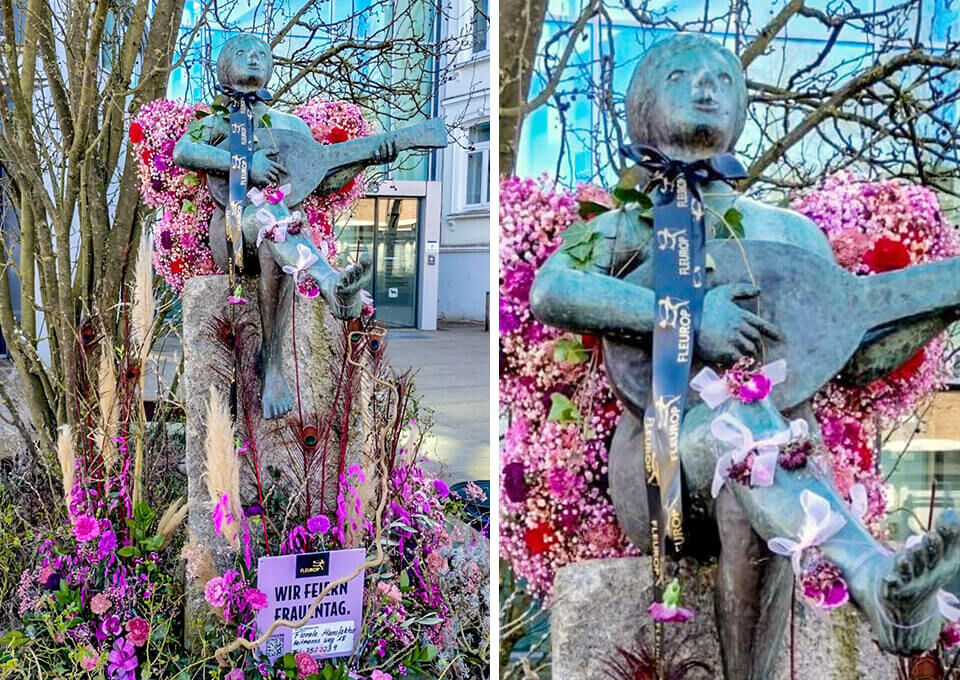
Buxtehude: Guitar Player
The statue of the guitar player is also known as the ‘Lute Singer’. The sculpture is one of many works of art in public spaces throughout the Hanseatic city that shape the cityscape and invite visitors to explore. The Lute Singer symbolises female artists, musicians and all women who touch and inspire others with their work.
Decorated by: Florale Manufaktur Buxtehude
Göttingen: Gänseliesel fountain
In the 20th century, women were clearly subordinate to men and had hardly any rights. With the placement of the Gänseliesel on the market square in 1901, the female presence in public life was strengthened and made visible. This female figure eventually also became a Göttingen landmark and therefore deserves flowers, especially on Women's Day - even without the tradition of kissing.
Decorated by: Blumeninsel Sudmeyer
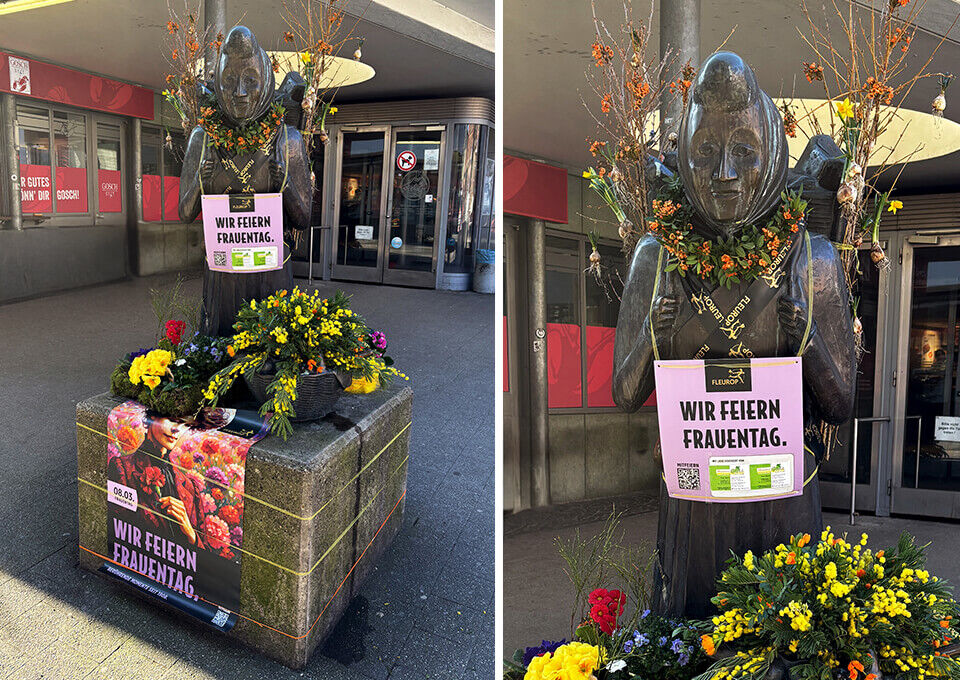
Hanover: Sculpture Market Woman
The sculpture of the market woman depicts Karoline Duhnsen, who characterised the image of the market hall for over 50 years. Every day, she brought fresh sausage products from the Schaumburg region to the city - a job that she carried out with tireless dedication. Karoline Duhnsen was an integral part of the market and was affectionately called ‘Grandma Duhnsen’ by everyone. Her presence and many years of service made her an important figure in the daily life of the market hall. She is a symbol of the women who, through their hard work and constant presence, helped to shape social life, even if this was often not recognised to the extent that their achievements deserved.
Decorated by: Blumen Flora
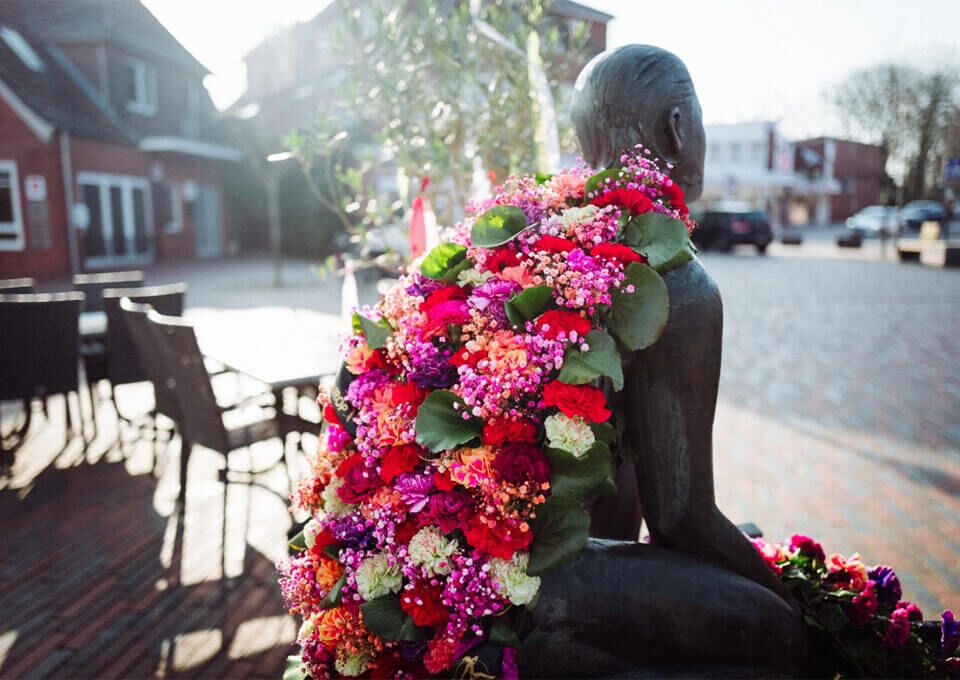
Horneburg: Statue of a midwife
The monument stands in memory of the two women from Horneburg, the midwife Olga Marie Katharina Bähr (1908-1994) and the so-called "woman of the dead" Katharina Lütje (1898-1980), who stood by the dying in their last hours and then assisted their relatives. The memorial is representative of the many dedicated women who all deserve to be honoured accordingly.
Decorated by: Blütenzauber, Silke Liebau
In North Rhine-Westphalia

Bonn: Bertha von Suttner
She was a pacifist, writer and the first woman to receive the Nobel Peace Prize for her tireless commitment to peace and her work to promote disarmament: Bertha von Suttner (1843-1914). She was also the woman who inspired Alfred Nobel to endow the prize. Above all, she fought against the discrimination of women, repressive sexual morals, poverty, class rule, narrow-minded nationalism, anti-Semitism, religious fanaticism and even against animal testing. In 1899, she was the only woman and non-governmental representative to take part in the 1st Hague Peace Conference in The Hague.
One of her famous quotes: "Revenge and always revenge! No sensible person would want to wash away ink stains with ink, oil stains with oil. Only blood, that is to be washed away again and again with blood."
Decorated by: Die Blüte - Scheidtweiler, Sabine
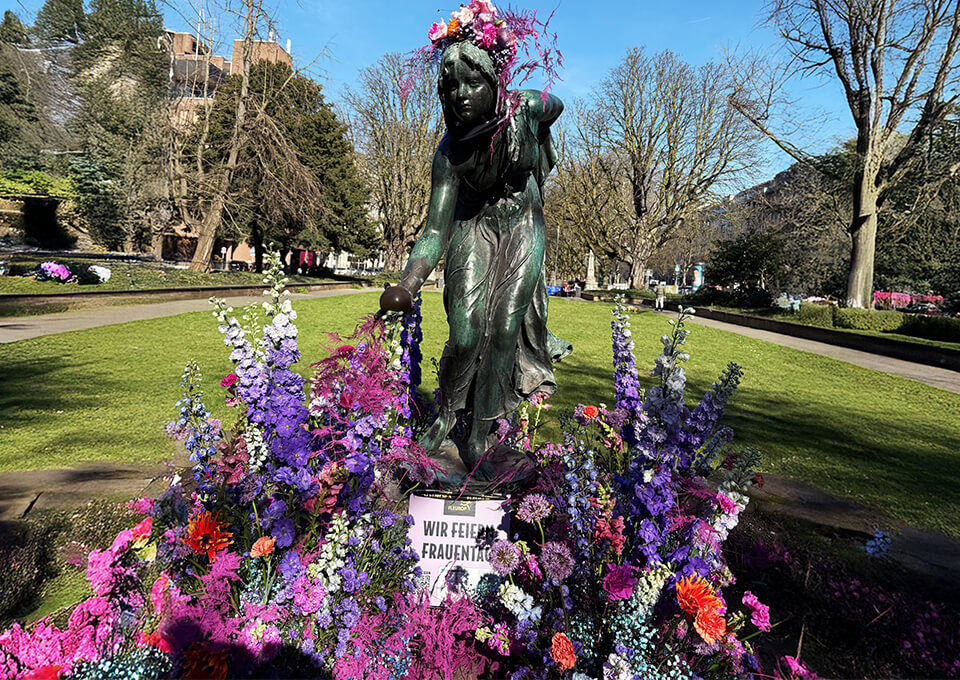
Düsseldorf: Ball player
The significance of the woman in the sculpture (1897) lies in the depiction of a self-confident, powerful figure who, despite her delicacy, radiates a form of independence and control. At the time the sculpture was created, such a depiction of women was still relatively unusual and represented a more modern view of femininity. The ‘ball player’ thus embodies a kind of female freedom and strength that contrasts with traditional, more passive depictions of women. It narrowly escaped being melted down during the Second World War and has been back in its place since 1947.
Decorated by: Blumenbinderei Gerhard Lehmann
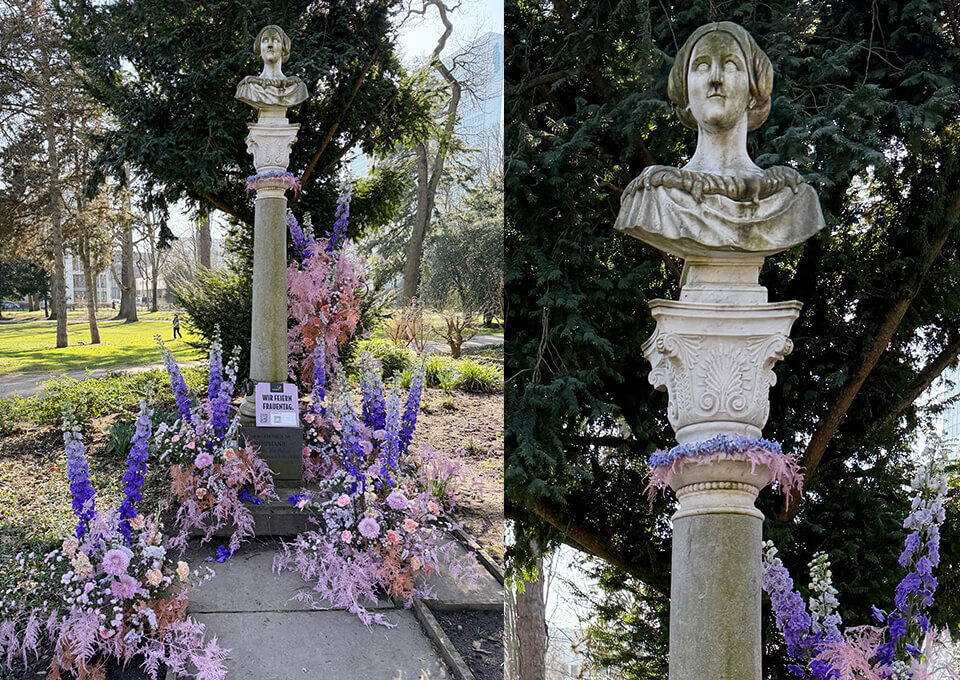
Düsseldorf: Stephanie of Portugal/Angel of the Poor
Every year on the second Sunday in May, the marksmen of Düsseldorf commemorate Princess Stephanie of Hohenzollern-Sigmaringen, who is remembered as the ‘Angel of the Poor’. Although she was only 22 years old, her short-lived marriage to the Portuguese King Peter V and her commitment to the poor shaped the image of a selfless monarch. Even though she only sat on the Portuguese throne for a short time, she remains unforgotten as a symbol of charity and a tragic figure of European royalty.
Decorated by: Blumenbinderei Gerhard Lehmann
Wuppertal: Lasker-Schüler monument
Else Lasker-Schüler (1869-1945) was a Jewish poet, draughtswoman, outsider and flamboyant and is considered one of the most important voices in 20th century German literature. She devoted herself primarily to women's poetry and depicted female desire with great candour. She is directed against the 19th century's hostility towards instinct and lust. Her poetic legacy is of lasting importance. Her works are still valued today for their originality, powerful language and their ability to express profound experiences.
Decorated by: Blumenhaase
In Saxony
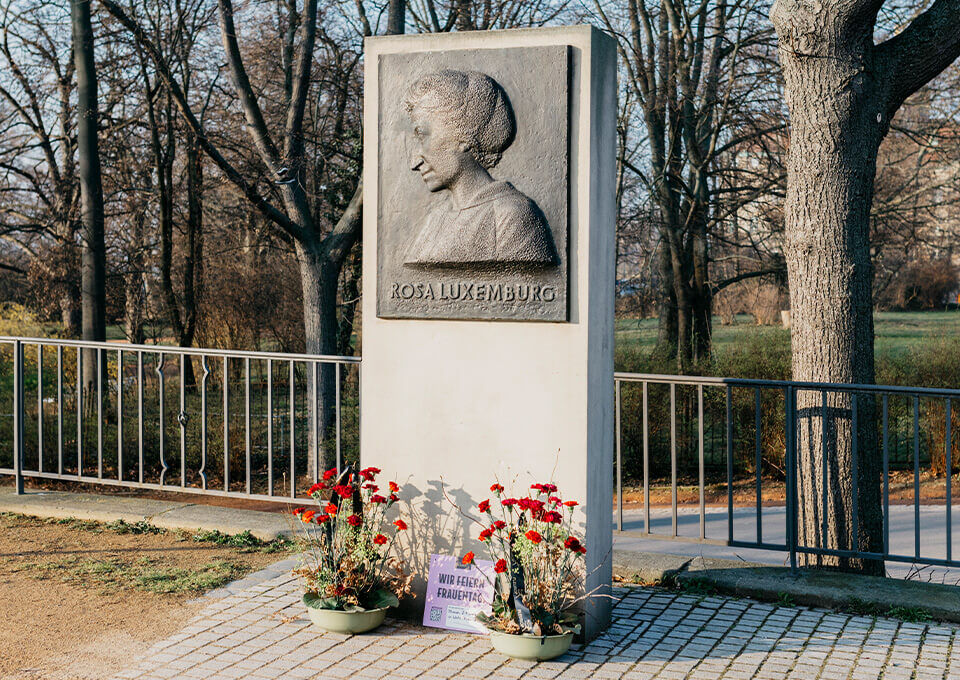
Dresden: Rosa Luxemburg
Rosa Luxemburg (1871-1919) was born into a Jewish family in what was then the Russian Empire (now Poland) and her talent was already evident in her childhood: she learned five languages and taught herself to read and write. She graduated from high school in Warsaw at the top of her class and became politically active early on. Her activities and commitment repeatedly brought her into conflict with the authorities and her public protests against war eventually landed her in prison. She calls for the proletariat to take power and warns of the impending war. Rosa Luxemburg is not even 50 years old and her death marks a tragic end to her life and her revolutionary endeavors.
Decorated by: Blumen & Florales
Dresden: Trümmerfrauen memorial
"Now we were suddenly on an equal footing, authorized to do any dirty work. We didn't fight the war, we just lost it. Somehow we were born at the wrong time. We were young, our only luck, that was our bad luck. Because that will never come back. I'm so glad that young people are better off today. So much came - comes - too late for us. Or too early. We were single without a divorce and wore grandma's clothes even then. We were so young and already so spoiled. Our values had died with the people. We crawled to work to avoid dying, but life was really just vegetating." (Peter Ensikat, 1981)
Decorated by: Blumen & Florales
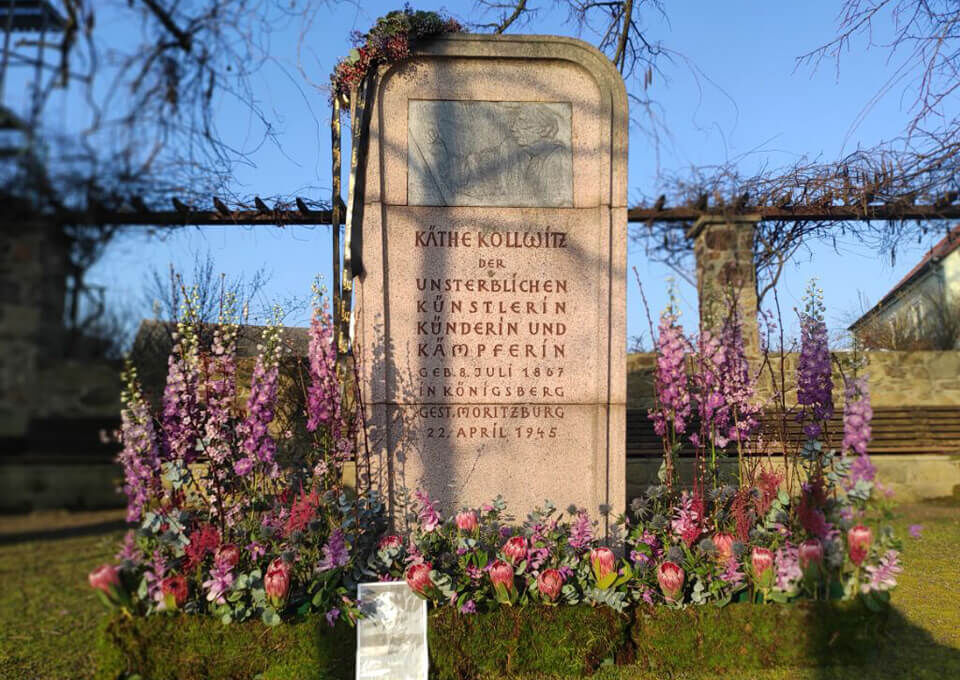
Moritzburg: Käthe Kollwitz
In 1919, Käthe Kollwitz (1867-1945) became the first woman to become a member of the Prussian Academy of Arts and was also appointed professor. With her art and leaflets, she campaigned against post-war hardship, hunger, misery and human loneliness. She also took a stand against National Socialism and after the National Socialist takeover, Käthe Kollwitz was asked to leave the Prussian Academy of Arts.
Decorated by: BlumenMehr
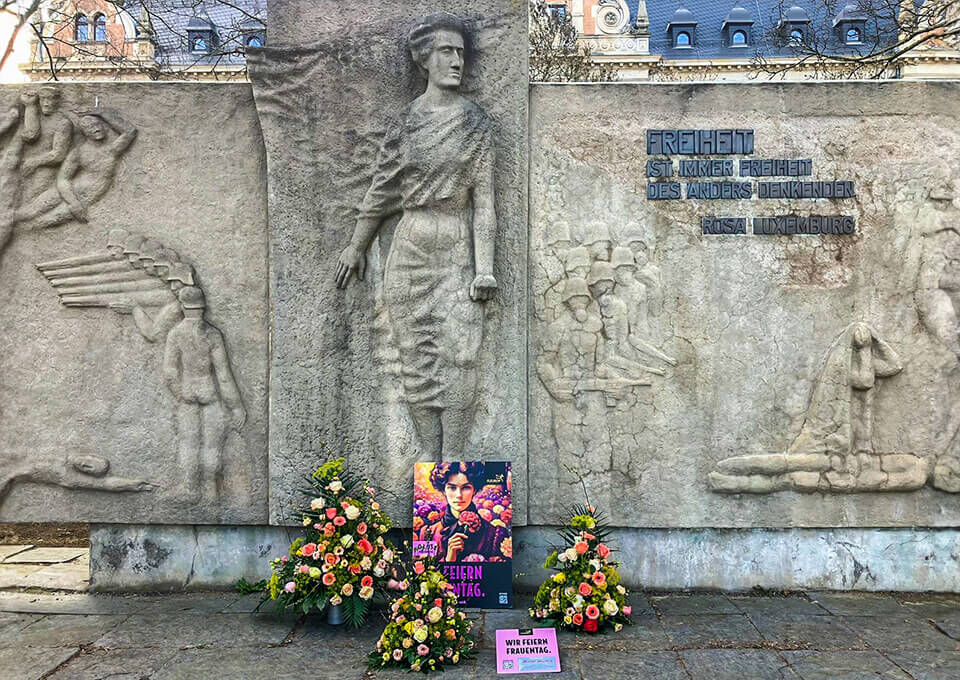
Zwickau: Rosa Luxemburg
Rosa Luxemburg's political commitment to the workers' movement and anti-militarism earned her many opponents. She described imperialism as the great power of all evil and saw world peace in danger. Together with Clara Zetkin and Karl Liebknecht, she founded the Spartacus Group, which later became the Communist Party of Germany (KPD). She criticized the reformist policies of the SPD and campaigned for a revolutionary transformation of society. Among other things, they rejected the idea of a dictatorship of the proletariat. In 1919, the so-called "Spartacus Uprising" was triggered against the transitional government under Friedrich Erbert. Although the Spartacus group only took part after the uprising had begun, Rosa Luxemburg and Karl Liebknecht were hunted down and murdered as leaders.
Decorated by: Blumen Gellrich
In Thuringia
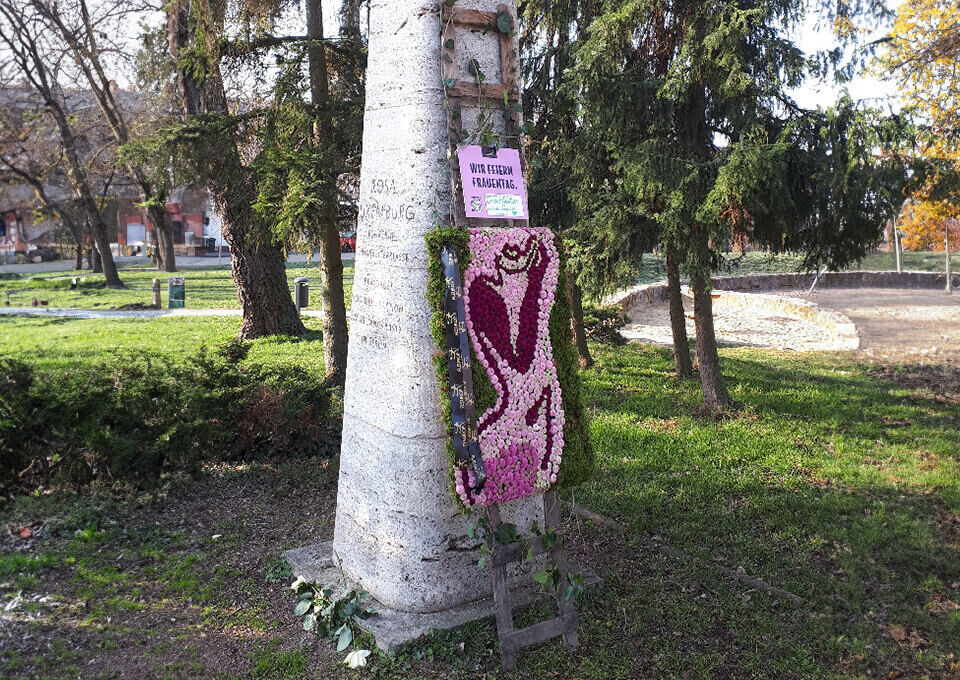
Weimar: Rosa Luxemburg
Rosa Luxemburg (1871-1919) was above all a champion of the workers' movement for those who thought differently. The murder of her and Karl Liebknecht goes down in history and marks a tragic end to her life and her revolutionary aspirations. Most of those involved in these murders were never brought to justice and the officer responsible later claimed that the Reich Chancellery had given him the go-ahead by telephone - although this cannot be proven beyond doubt to this day. Her body was also only found months later. Around 10,000 people follow her funeral procession.
Decorated by: SEELENFUTTER
Are you missing an important statue in your city that you would like us to decorate for Women's Day 2026?
Get in touch with us and, with a bit of luck, this statue will also be decorated by one of our florists for Women's Day next year.
Show appreciation with flowers
Although the value of Women's Day for society has changed over time, the pleasant gesture of surprising women with a floral greeting on this day has endured for many decades. In many places, friends, sisters, work colleagues or other strong women are surprised with flowers to say thank you.
Women's Day - Sayings & Congratulations
Women are like flowers: without them, their entire environment would not function and, incidentally, they make the world a more beautiful place.
These flowers are not for International Women's Day, but for the greatest woman in the world!
A little reminder that women like us can do anything! Happy Women's Day!
Today is a beautiful day for women power!
...for being the woman you are!
Women's Day is not about empowering women, because they already are. It is to teach the world to value that strength.















